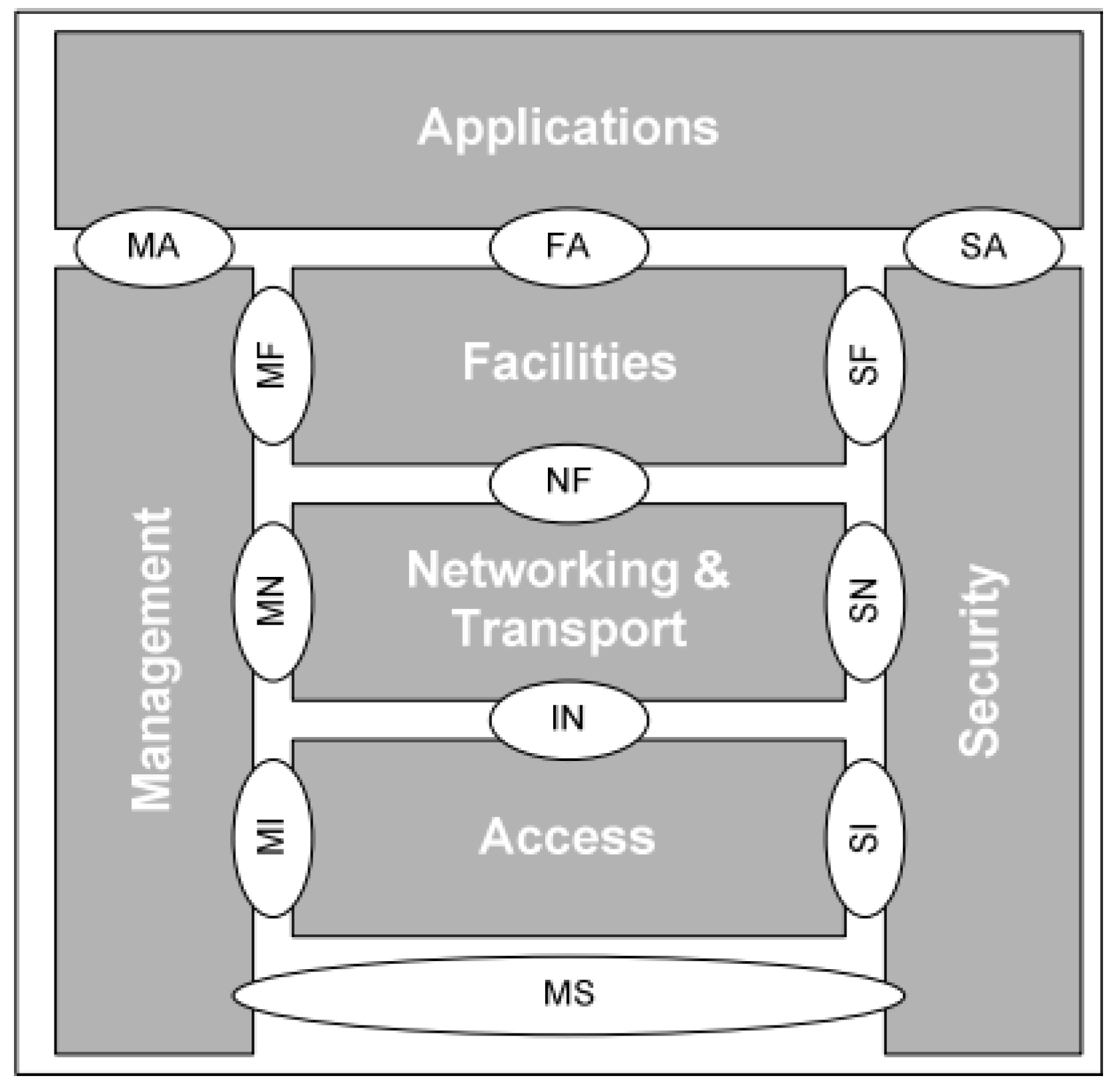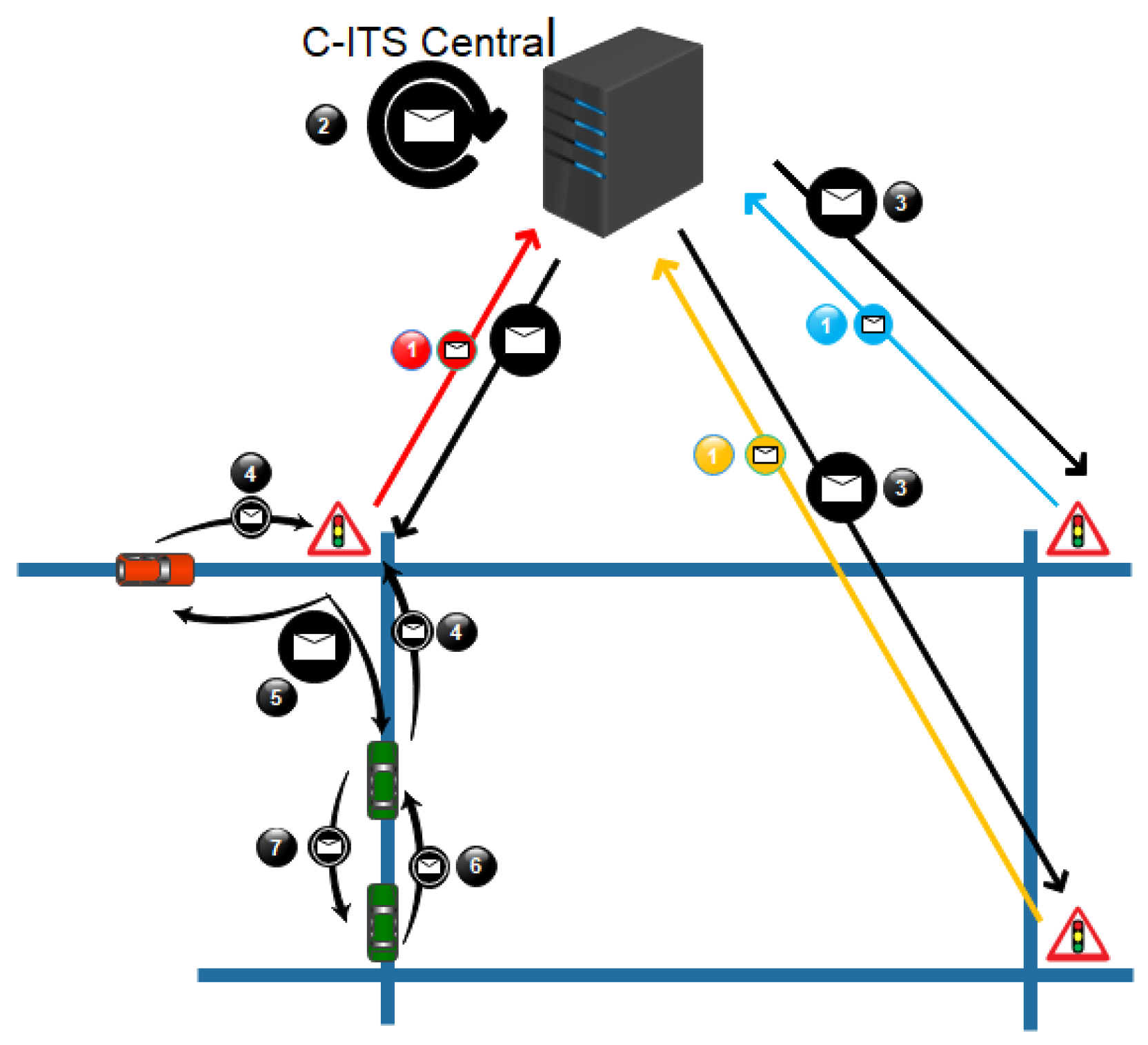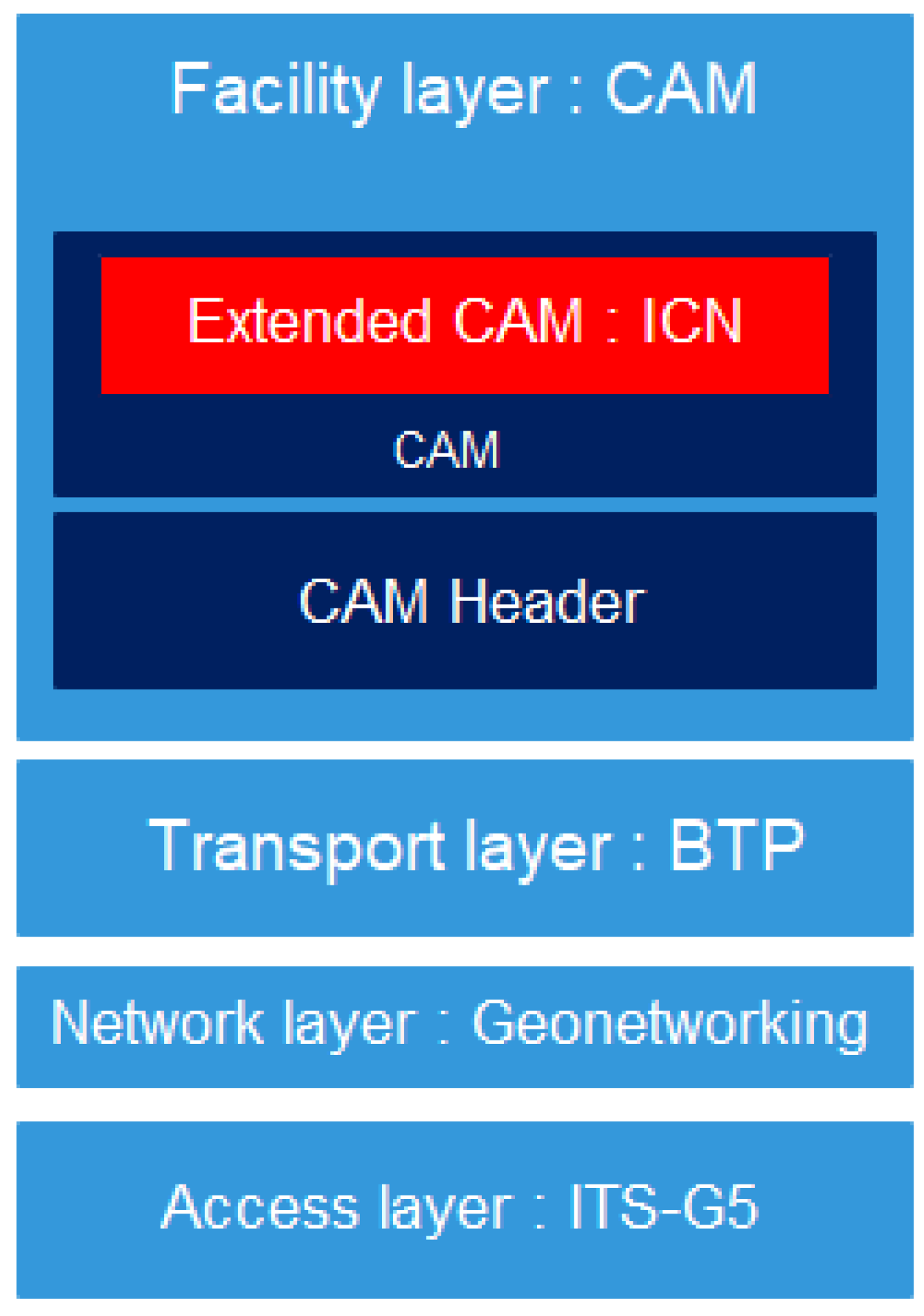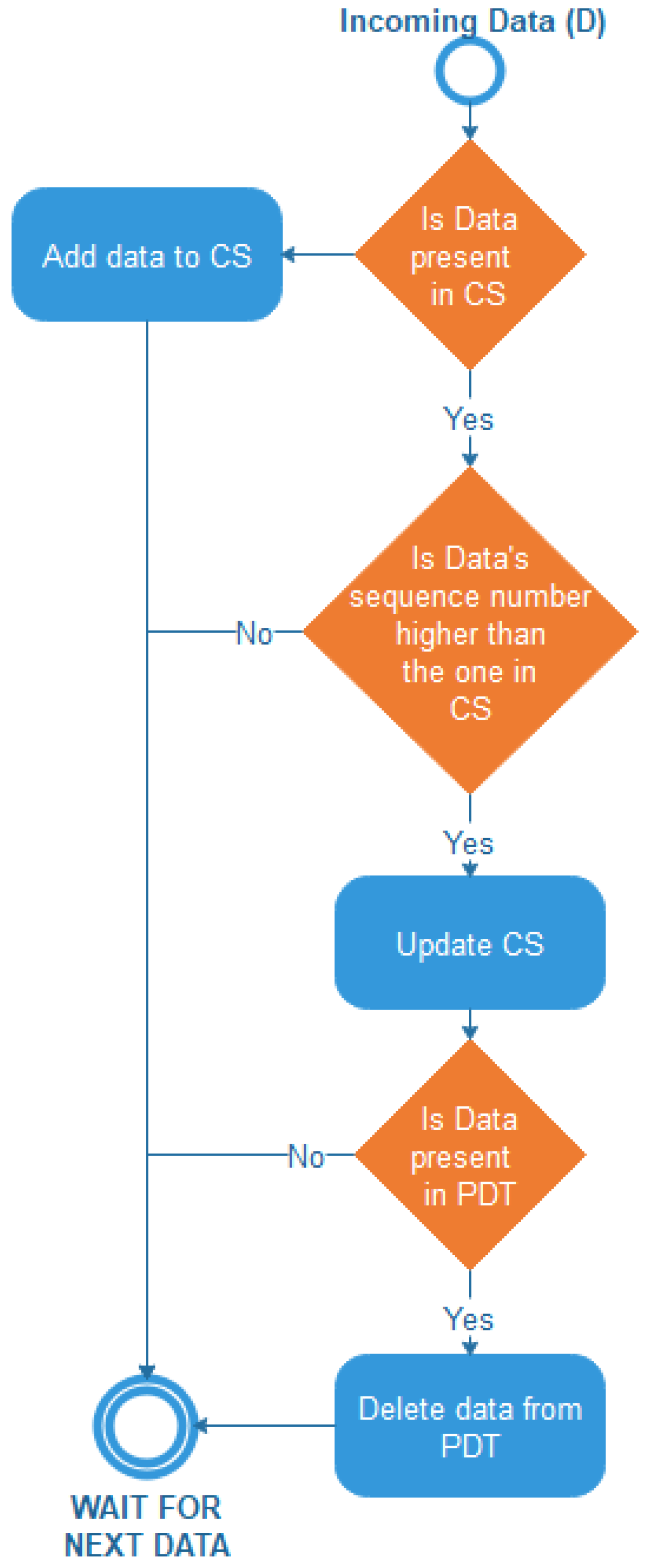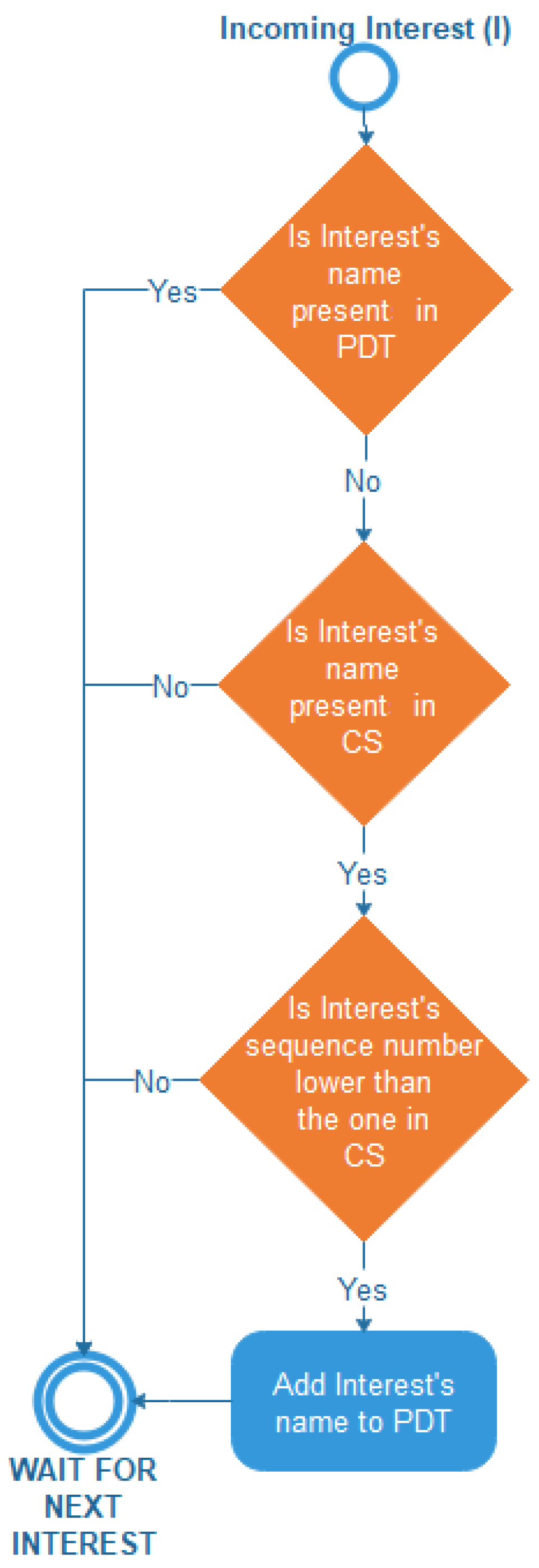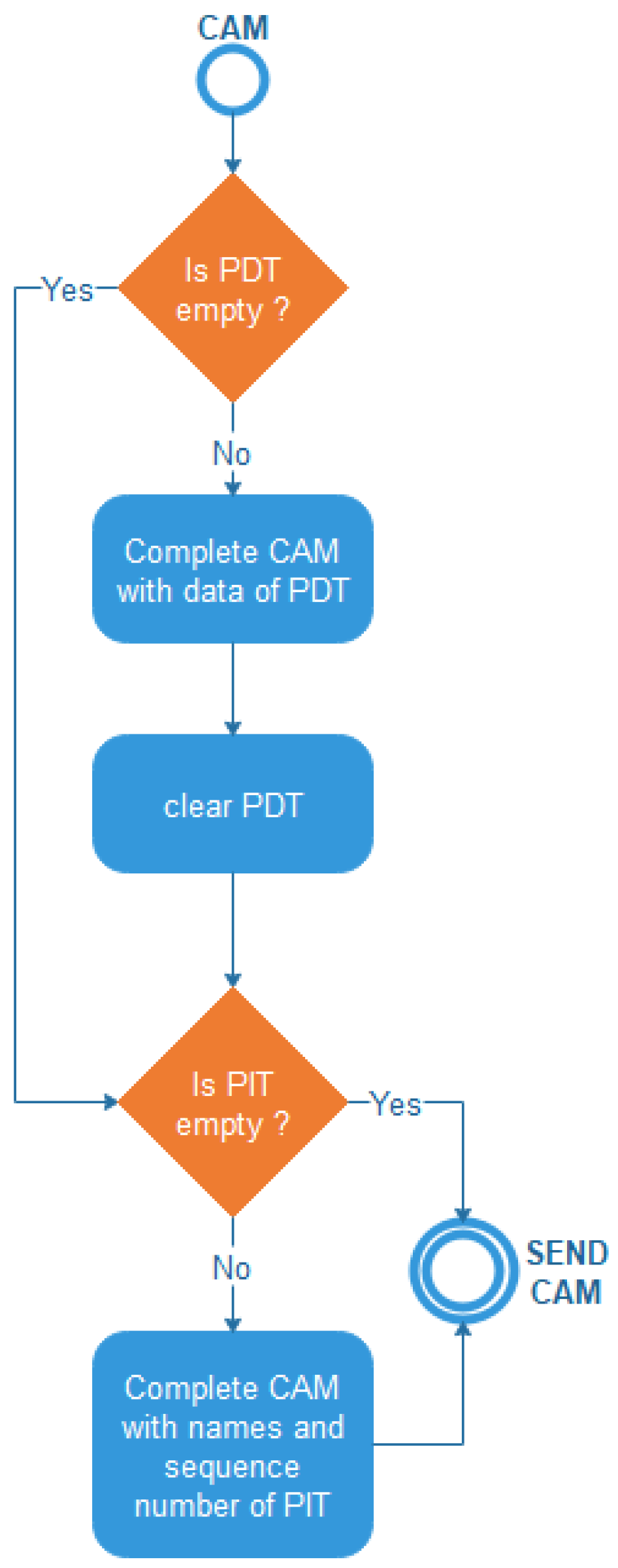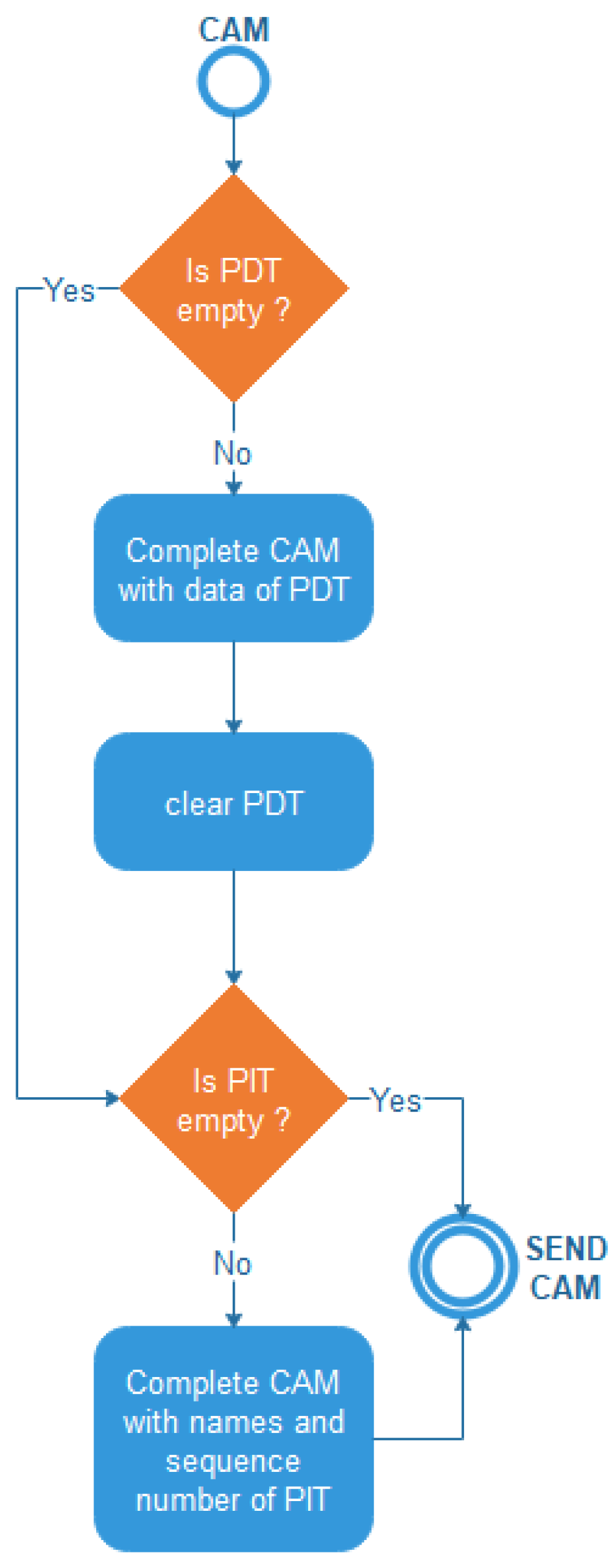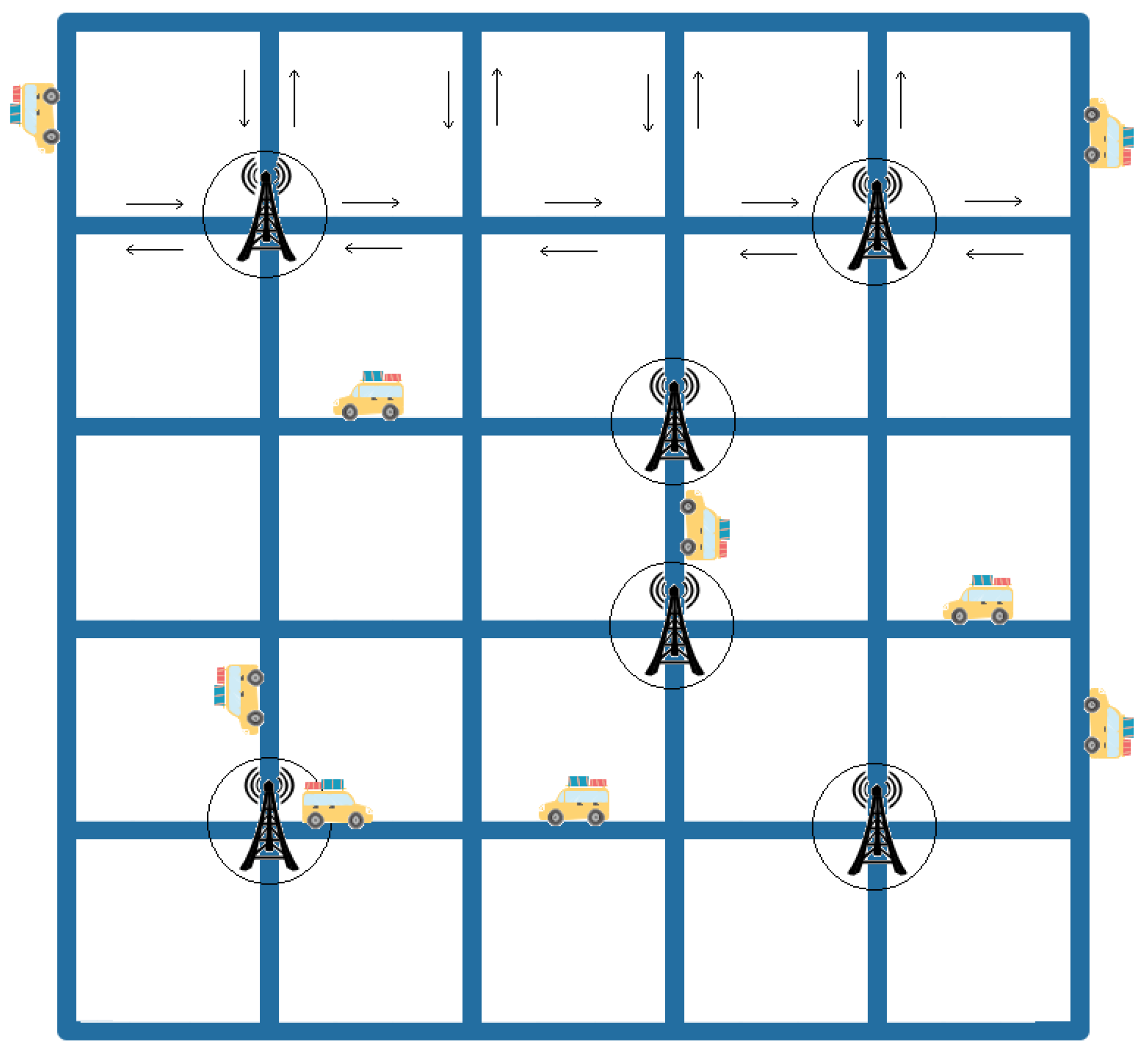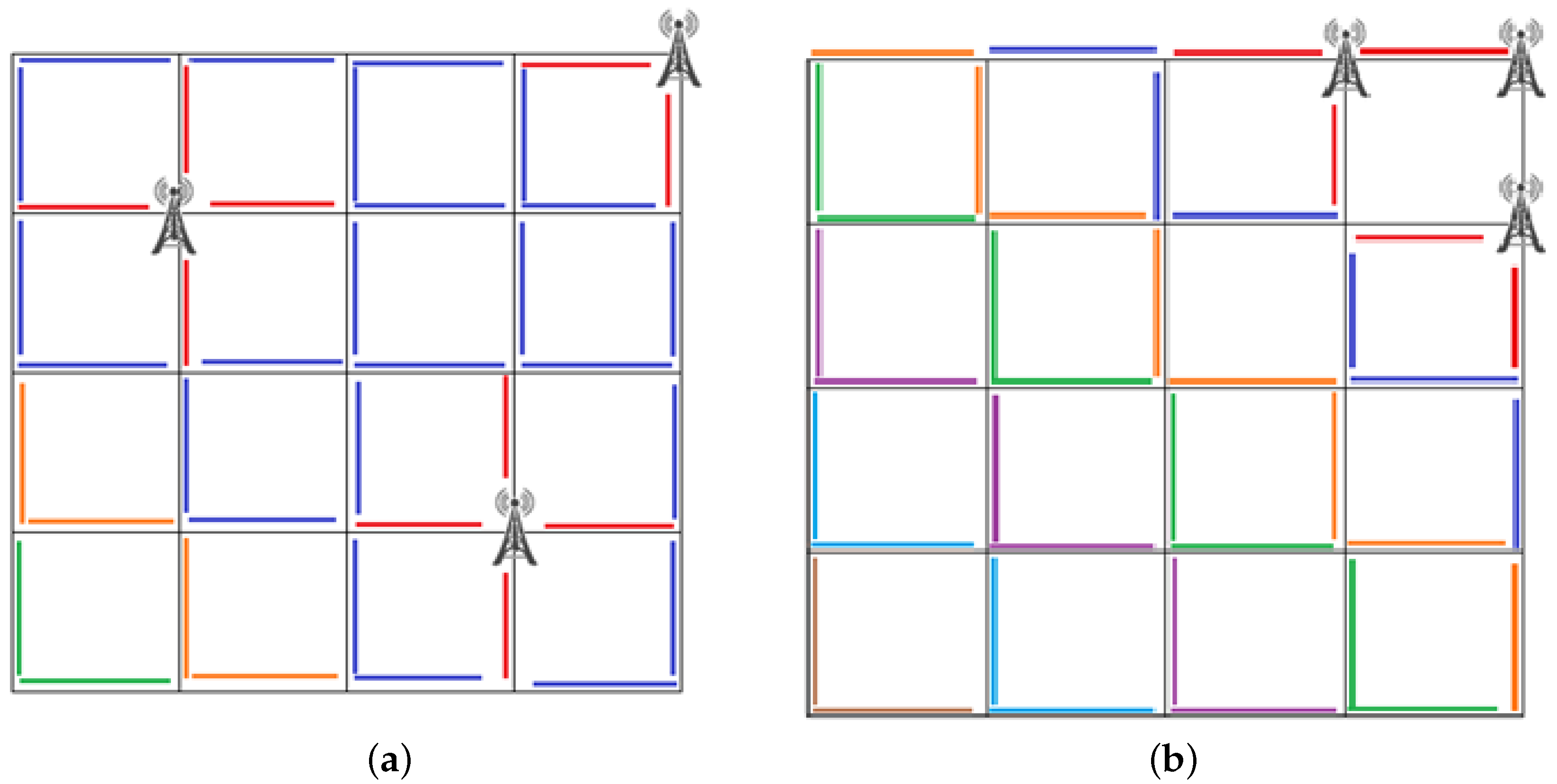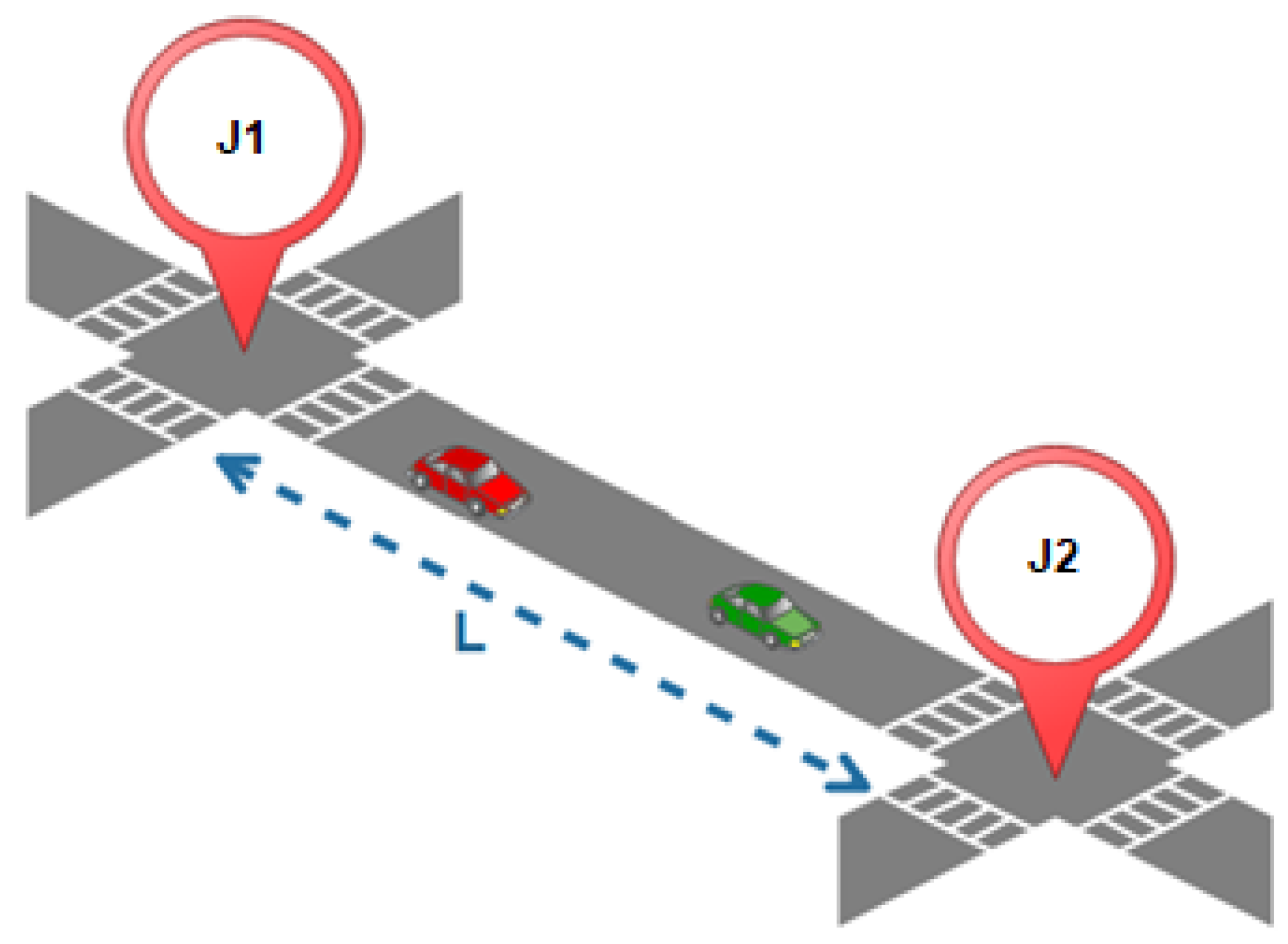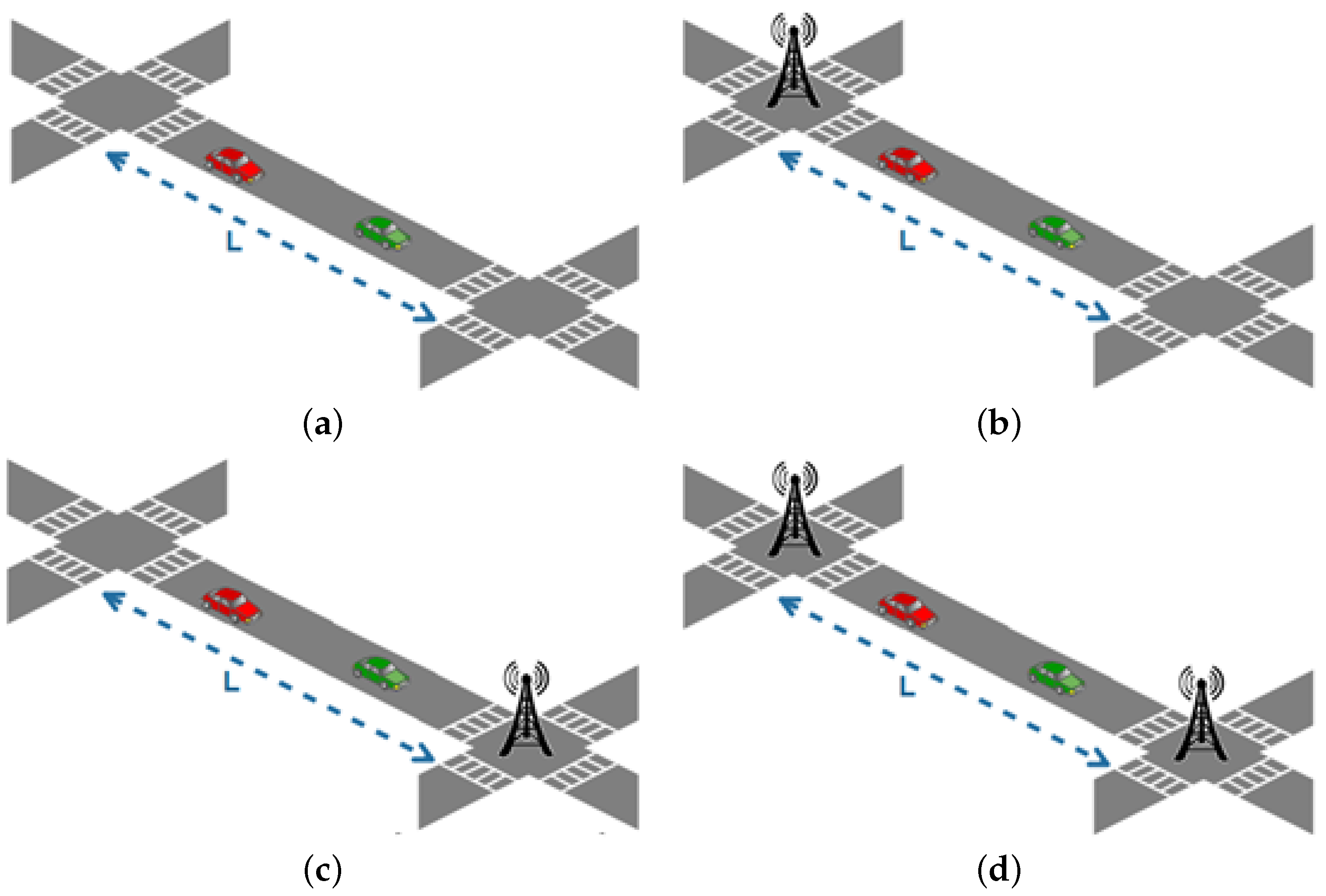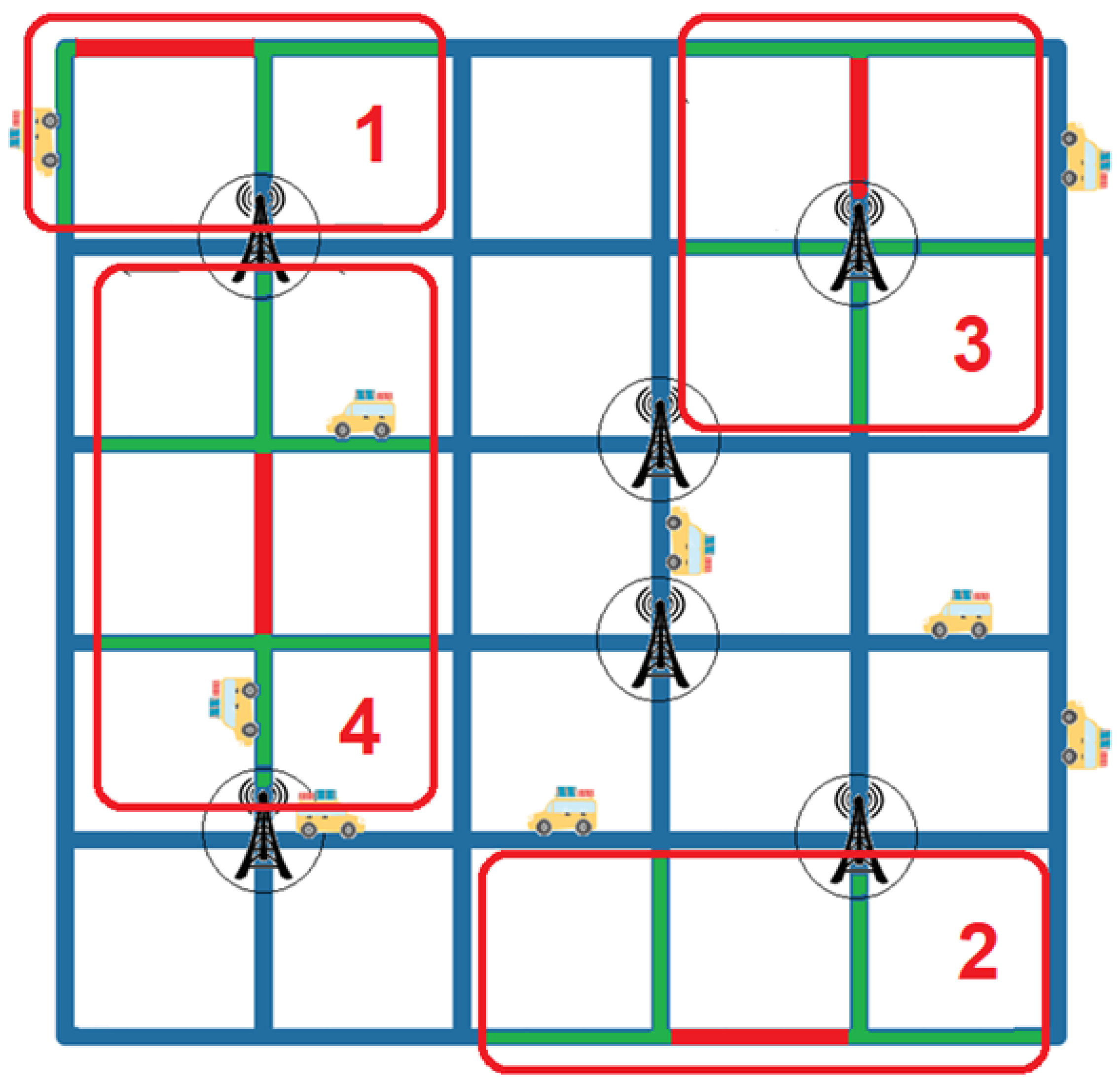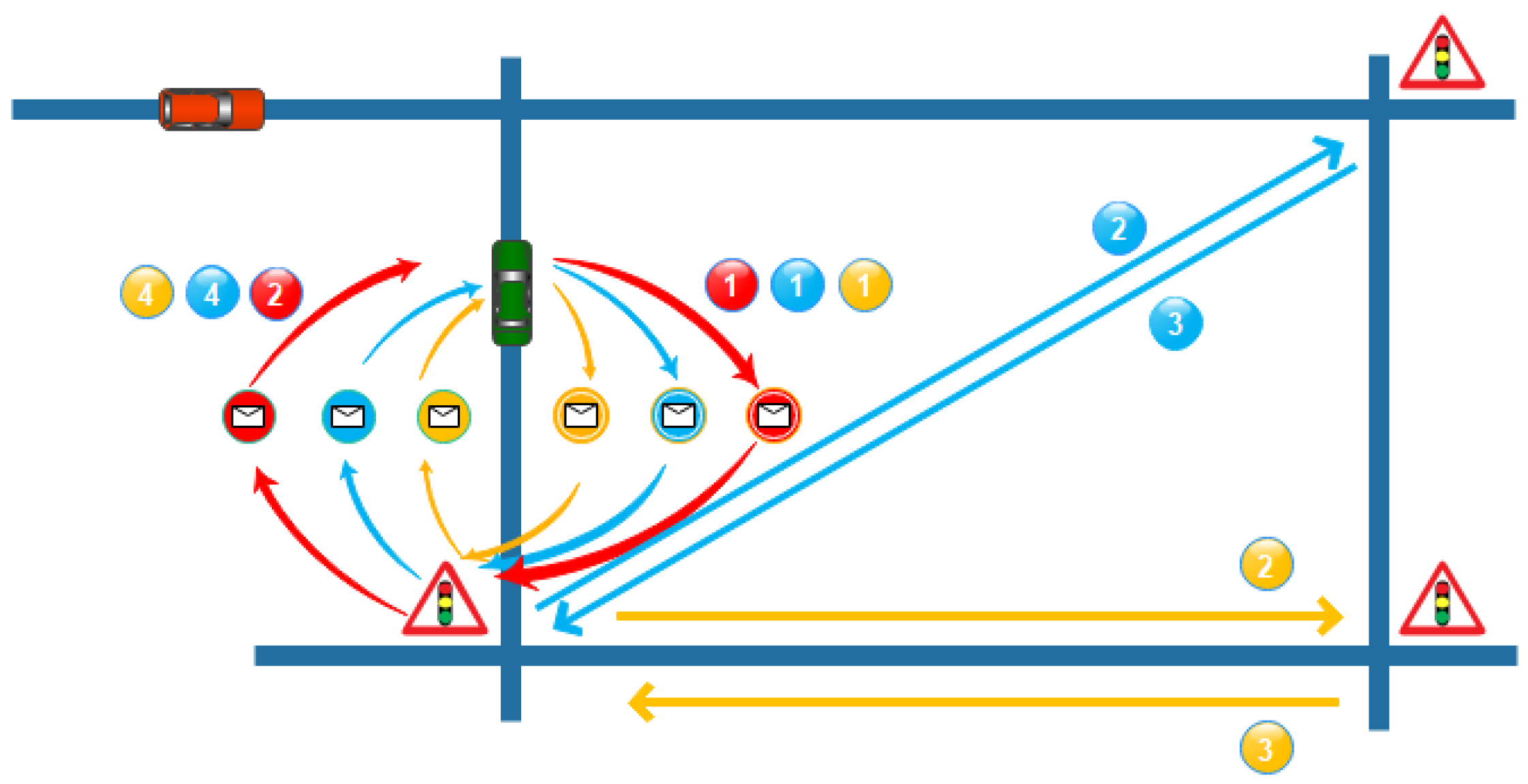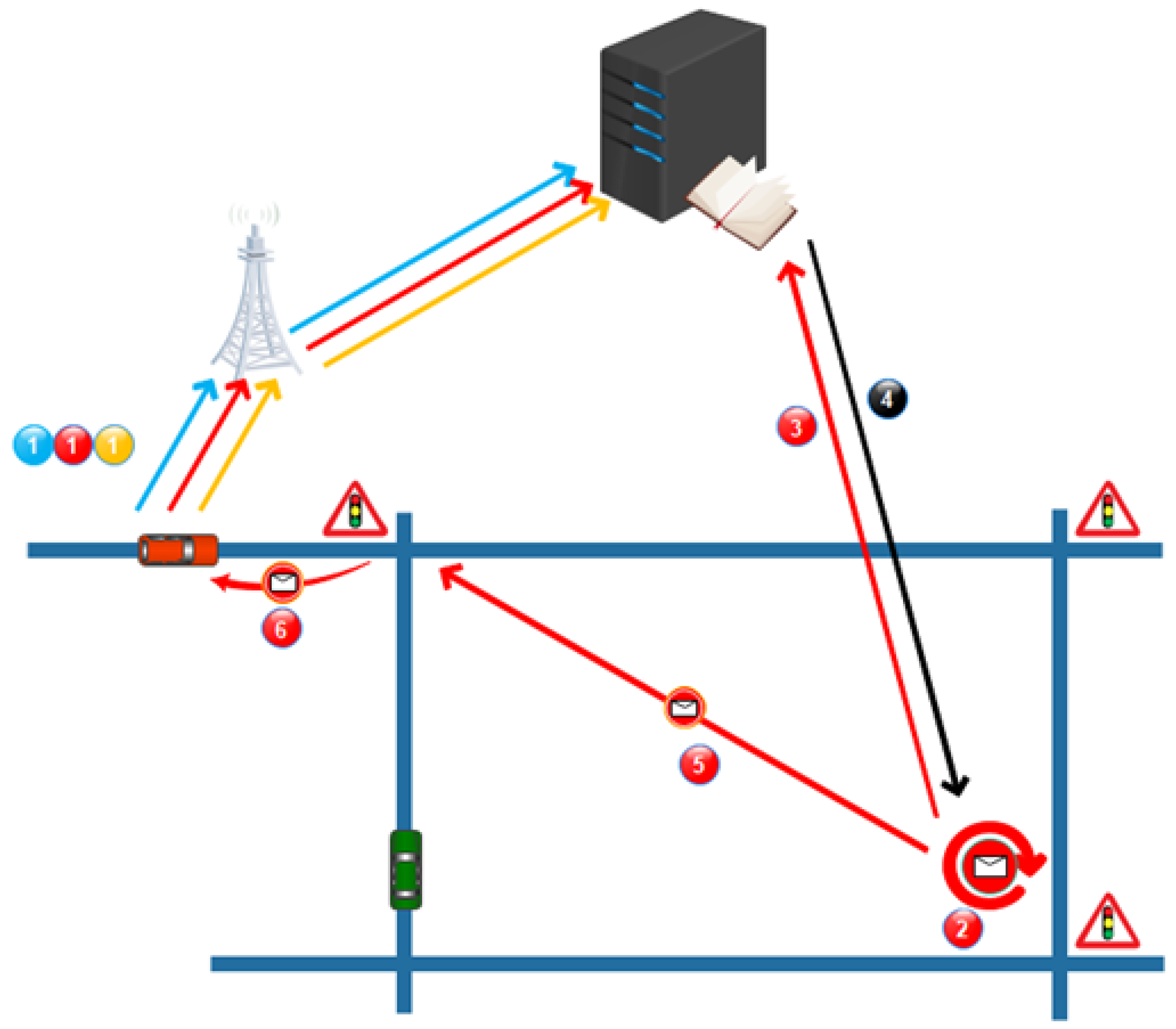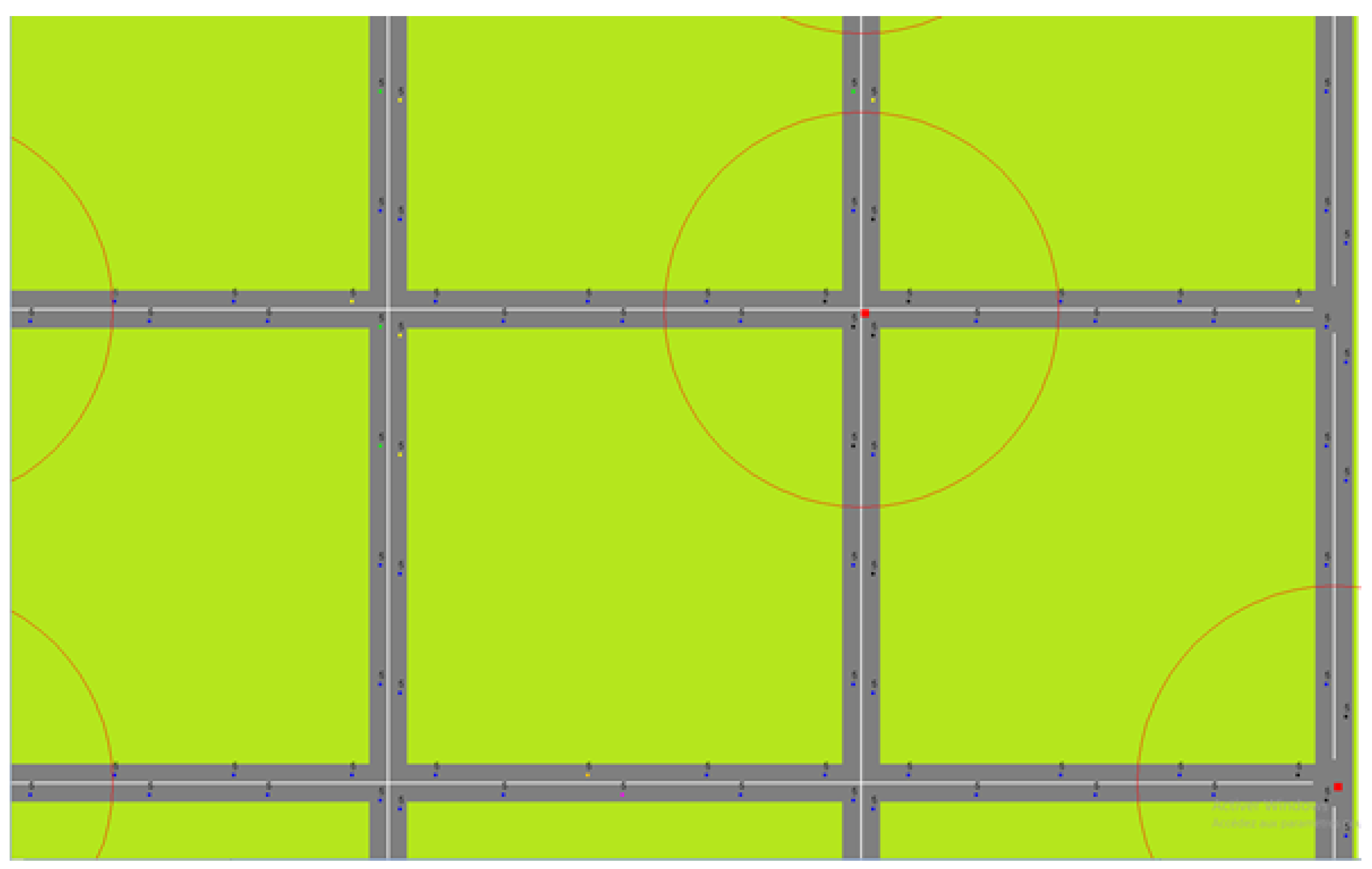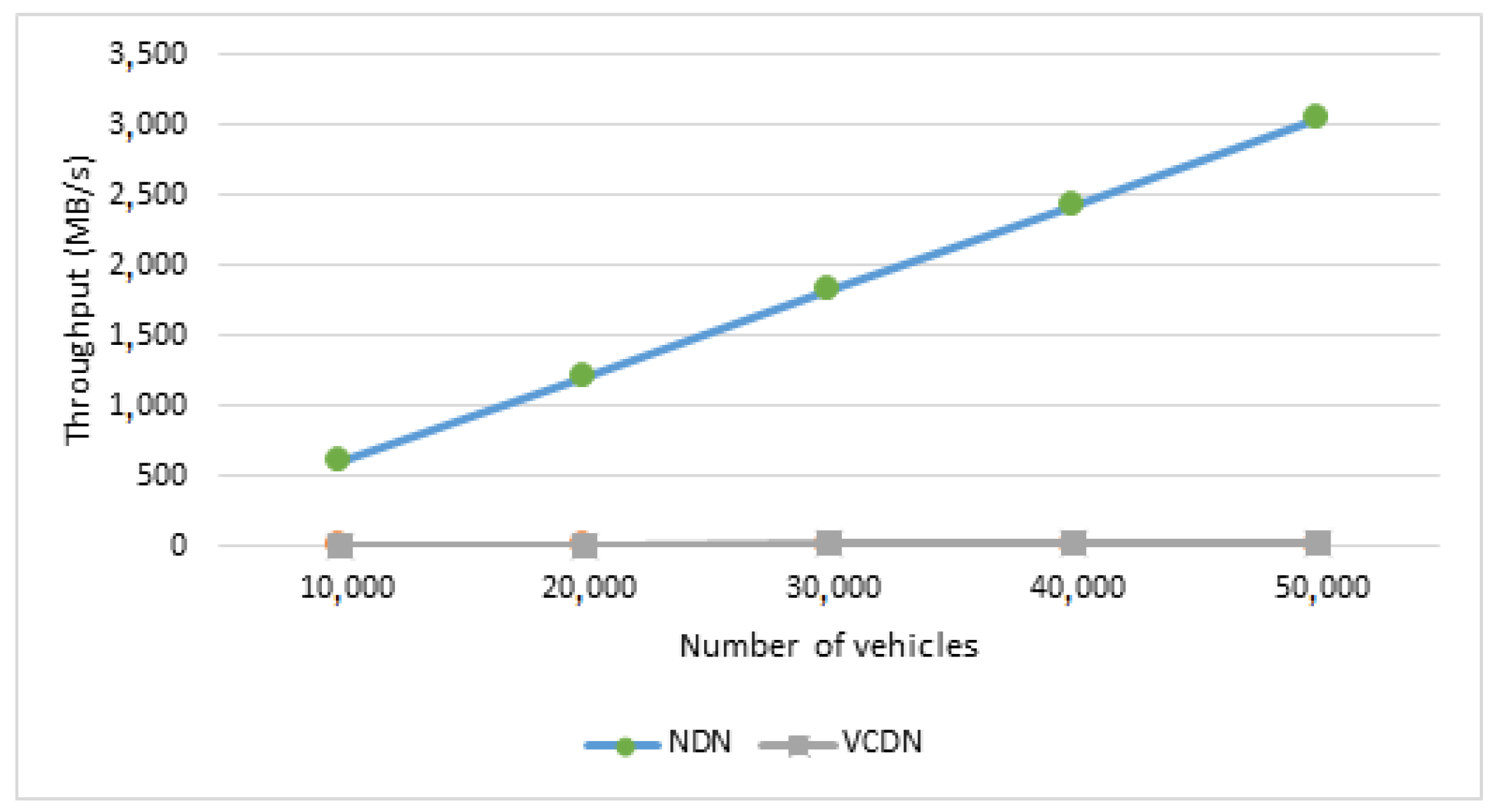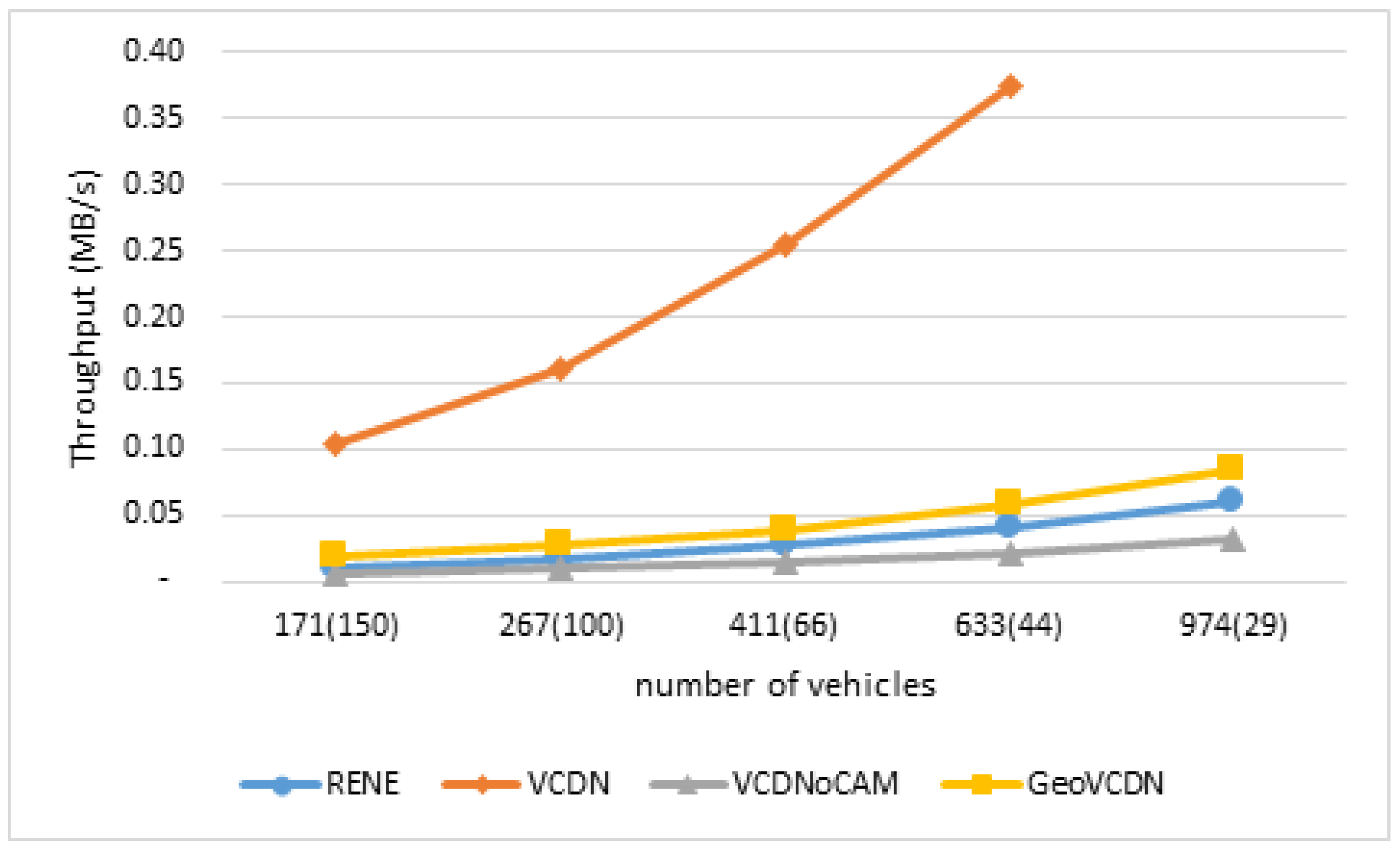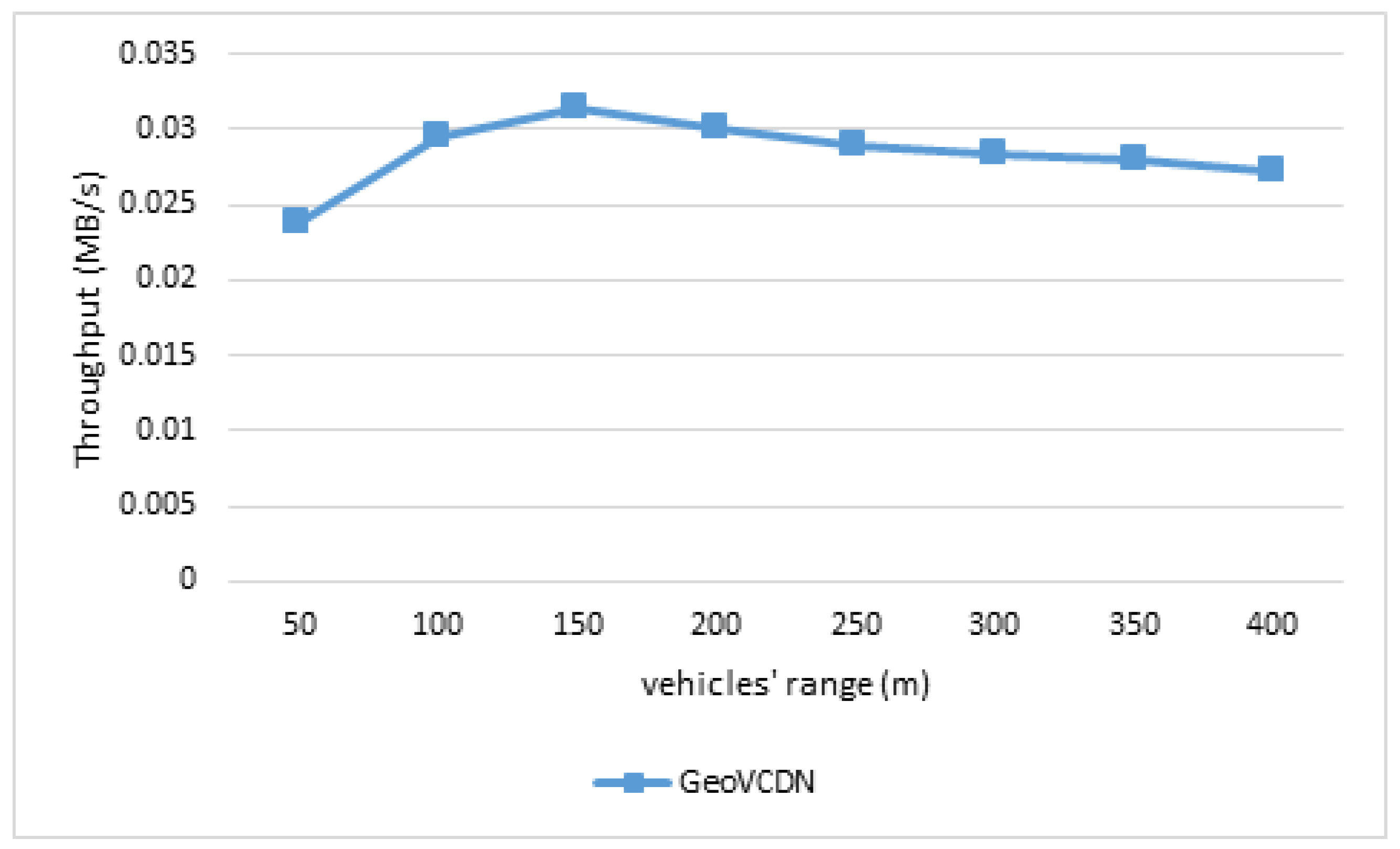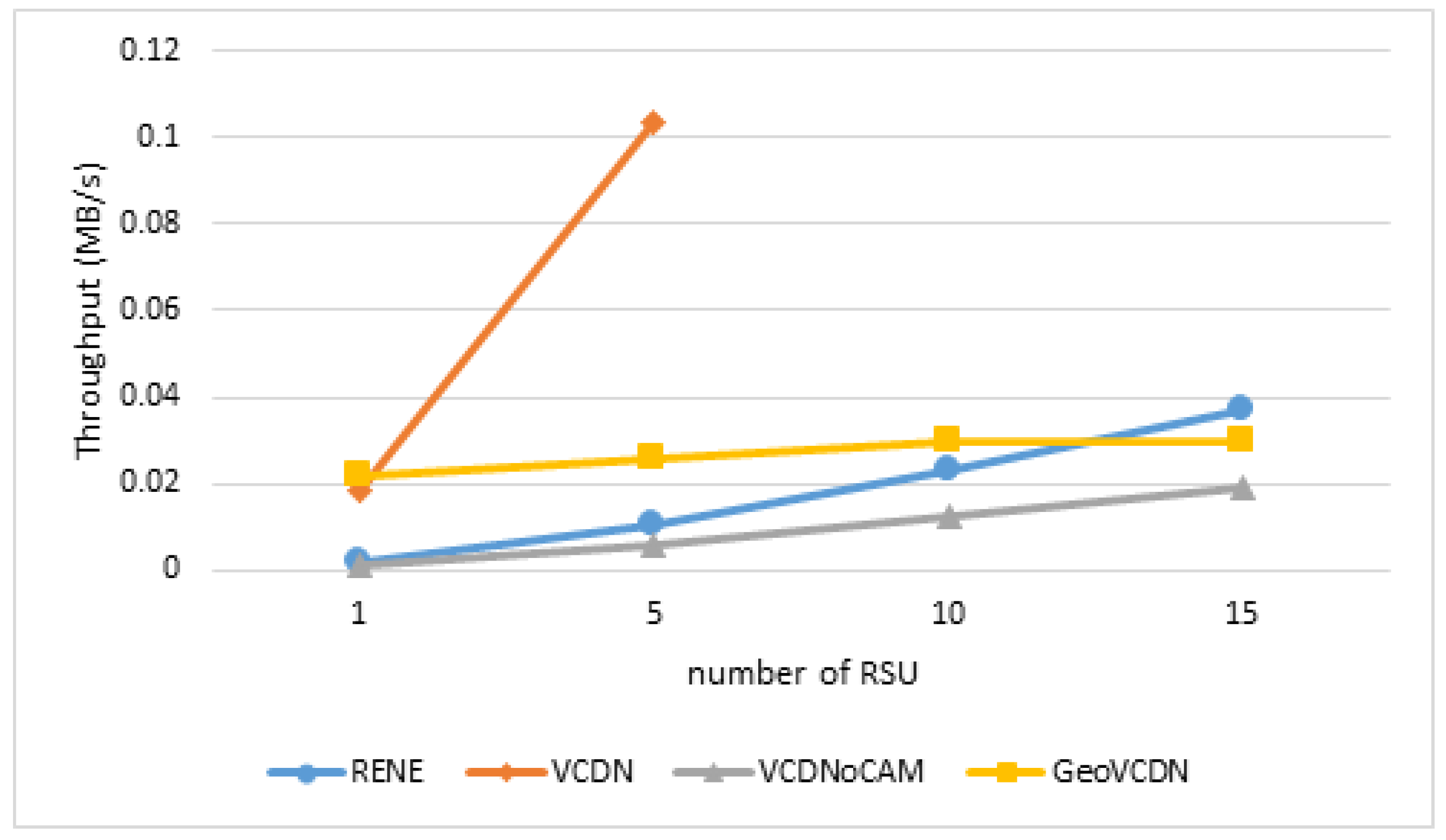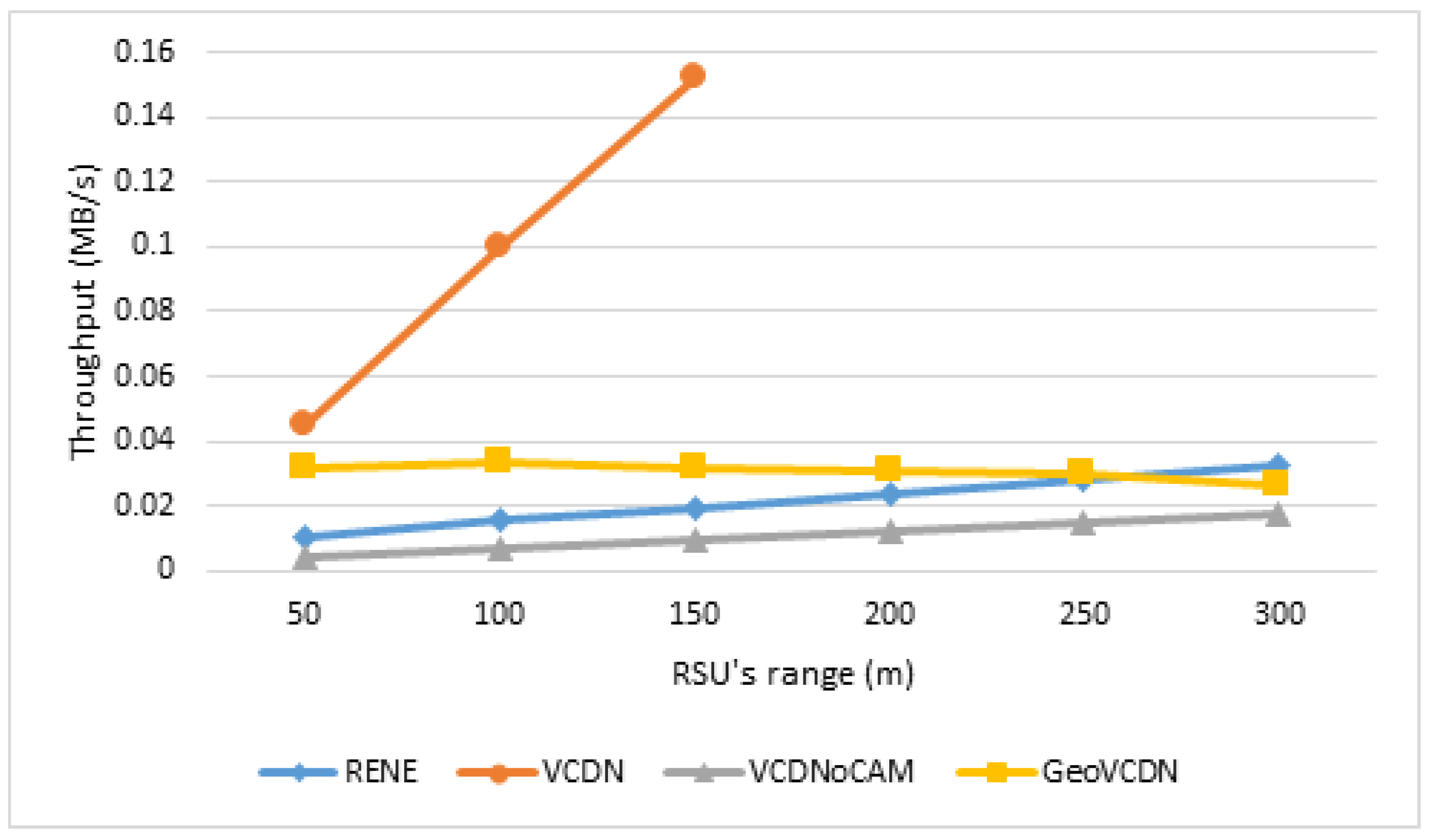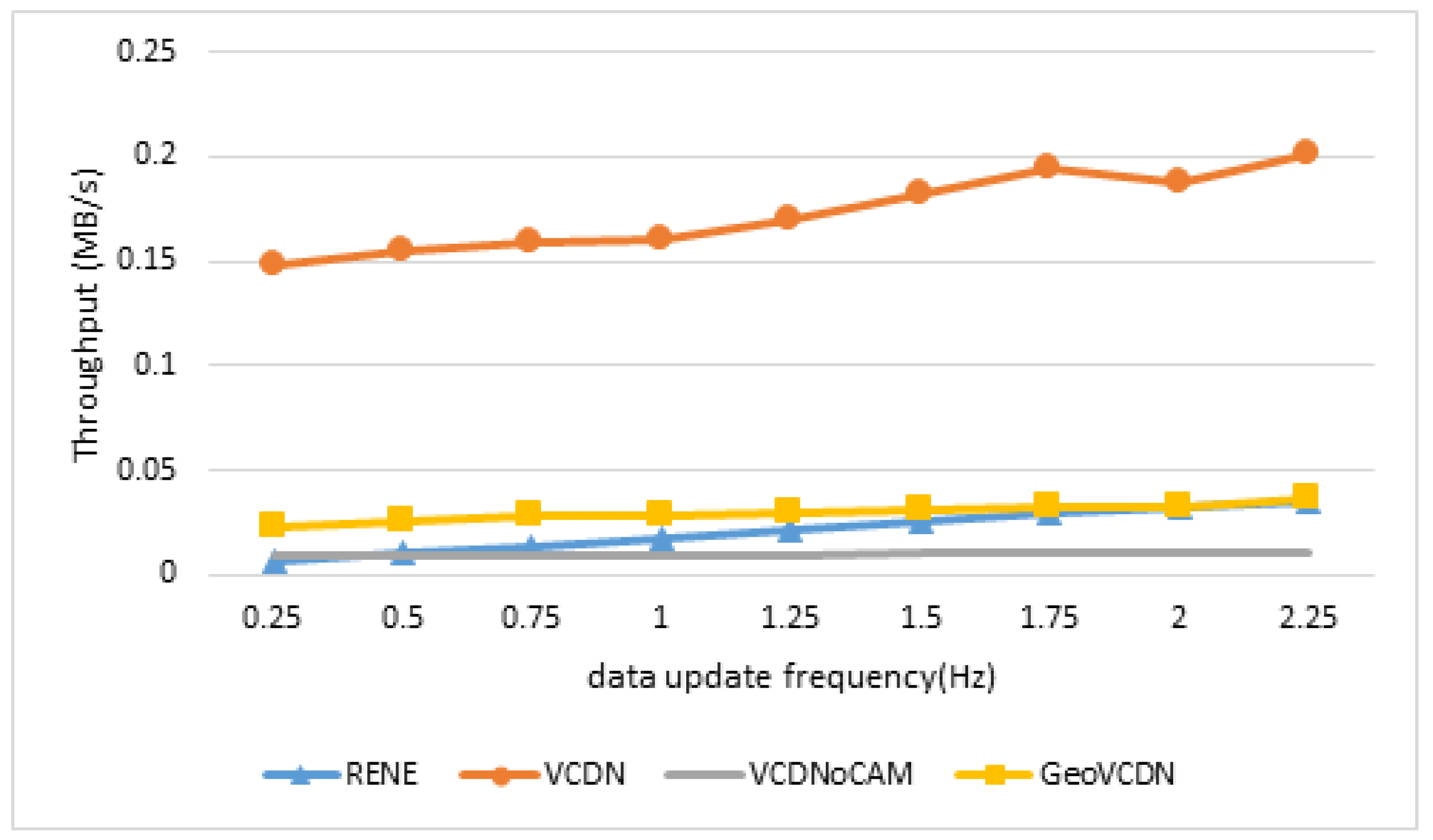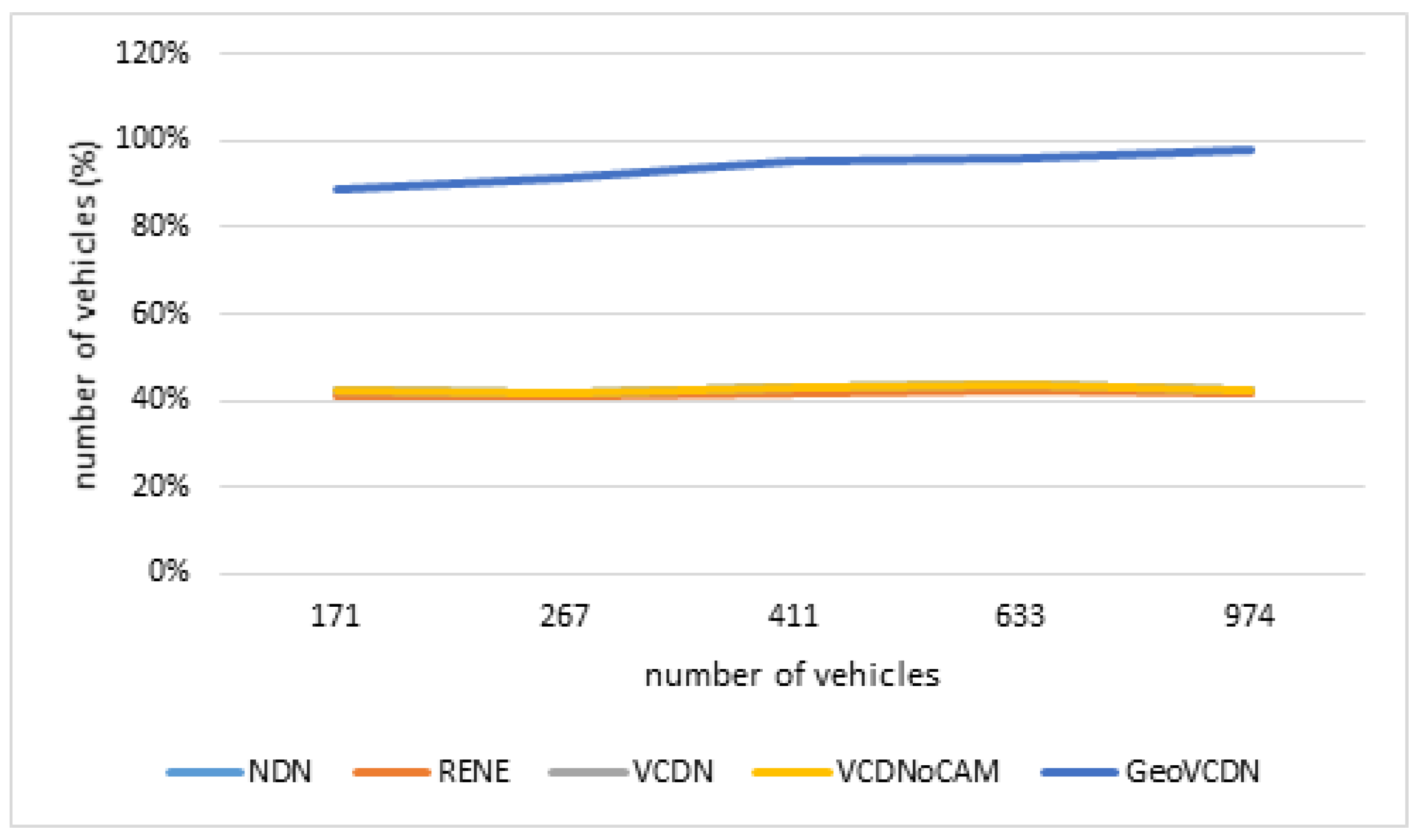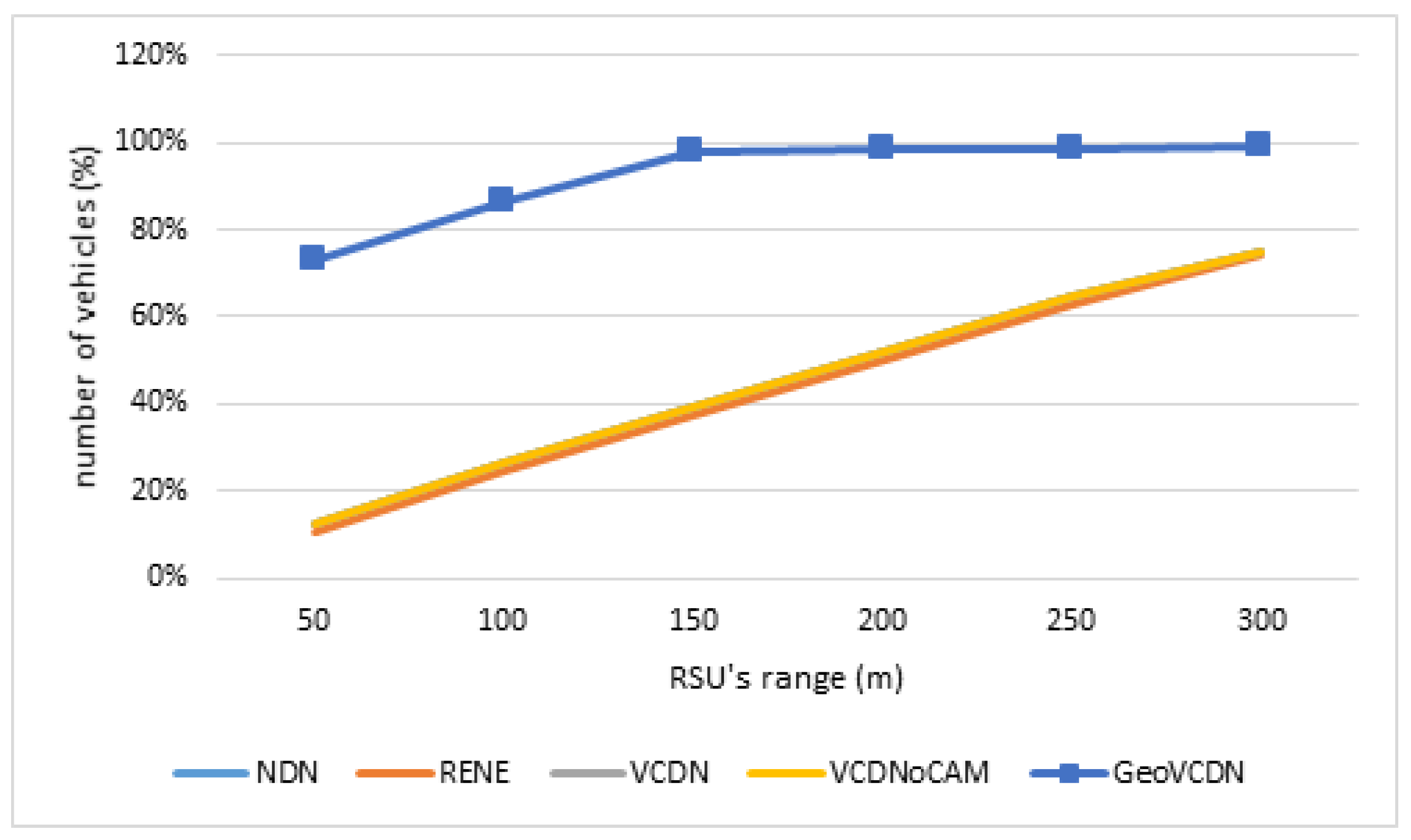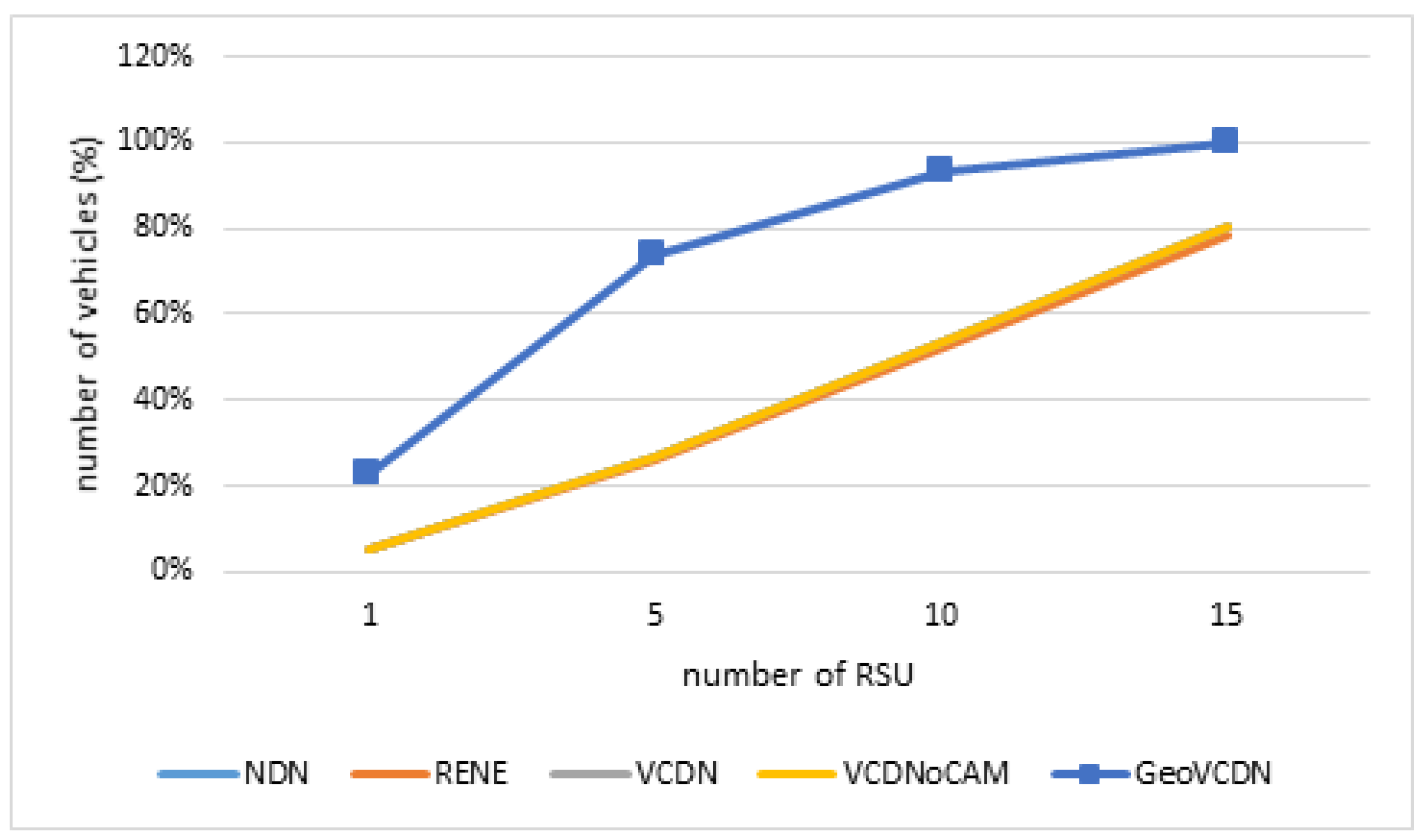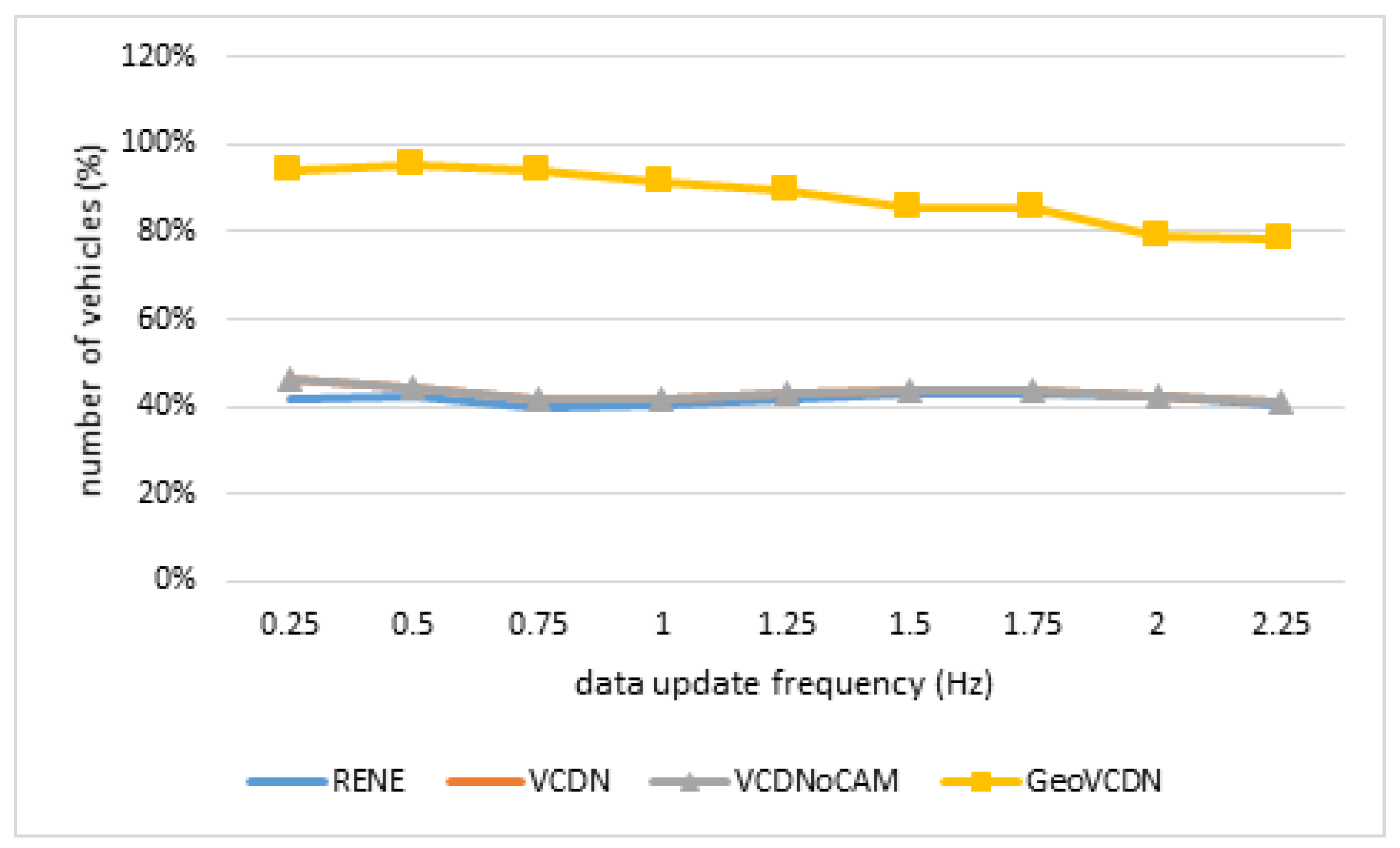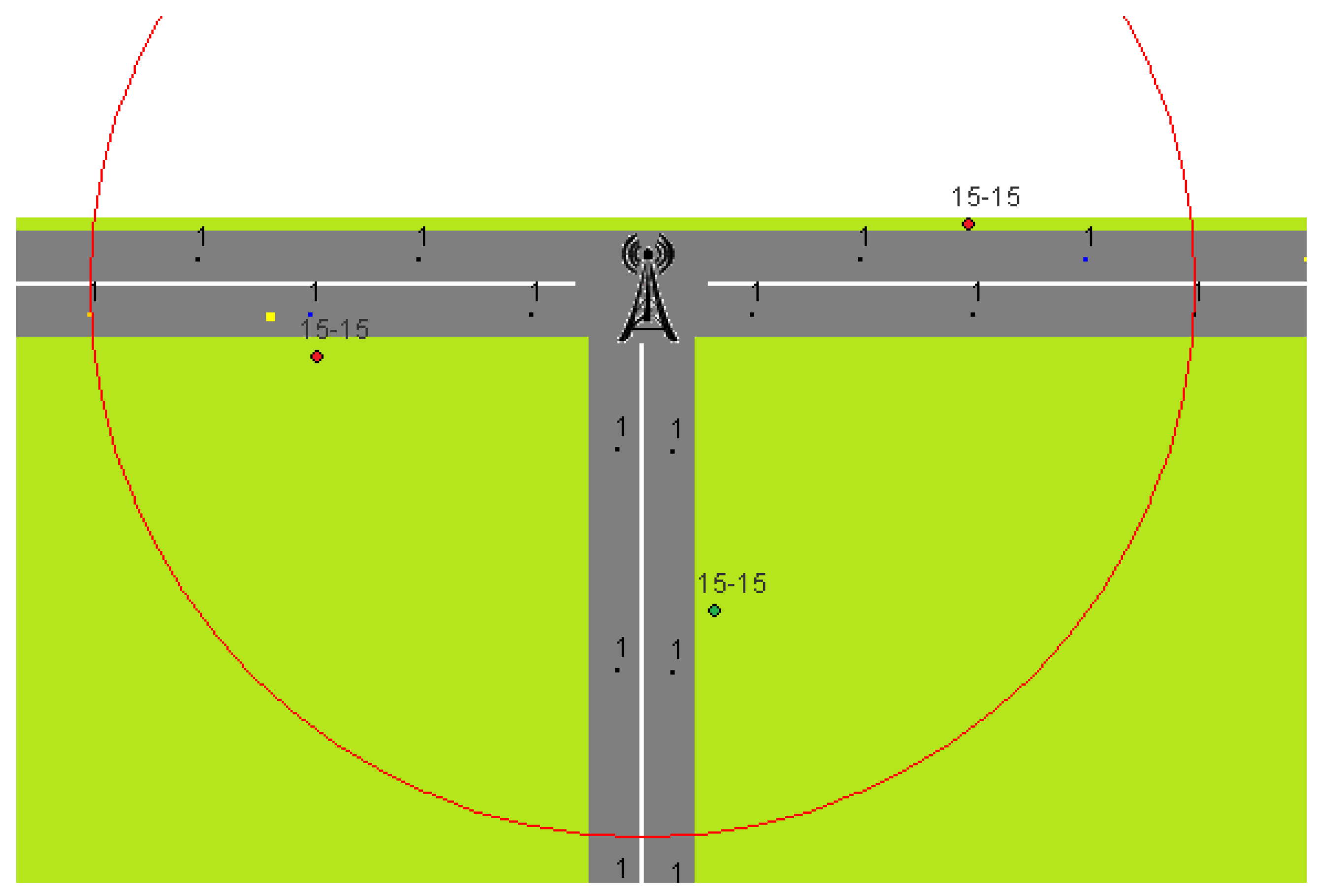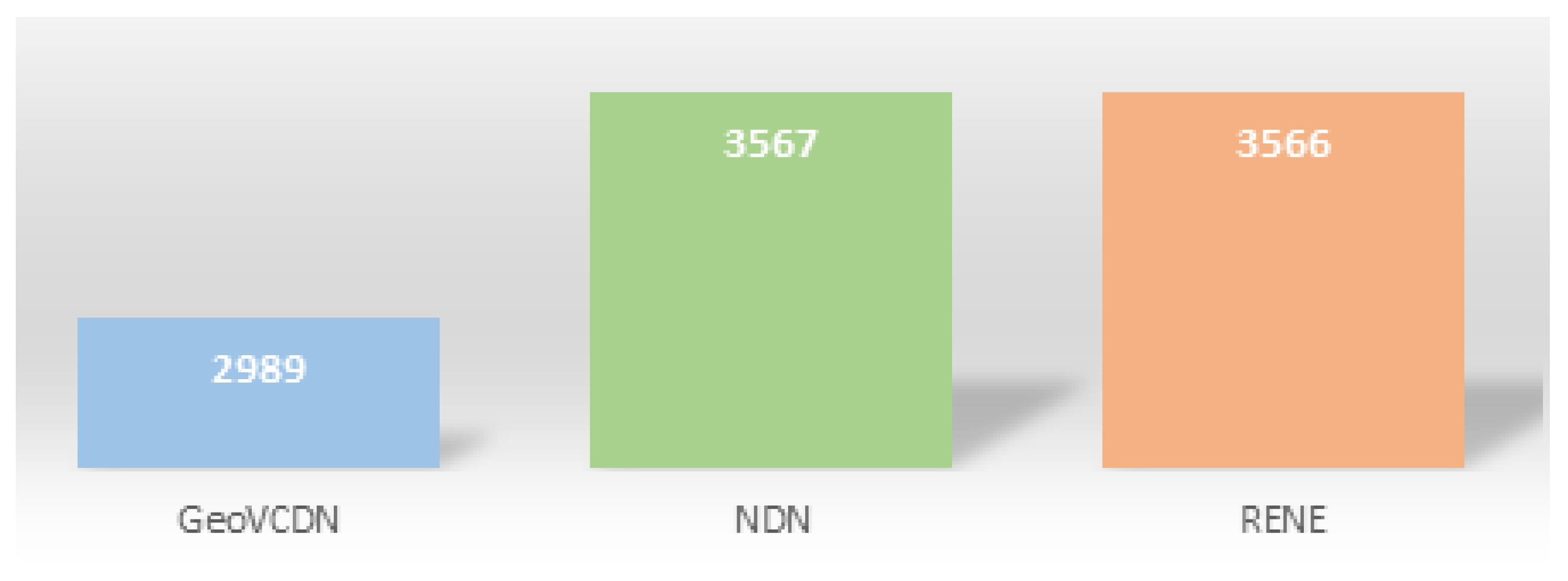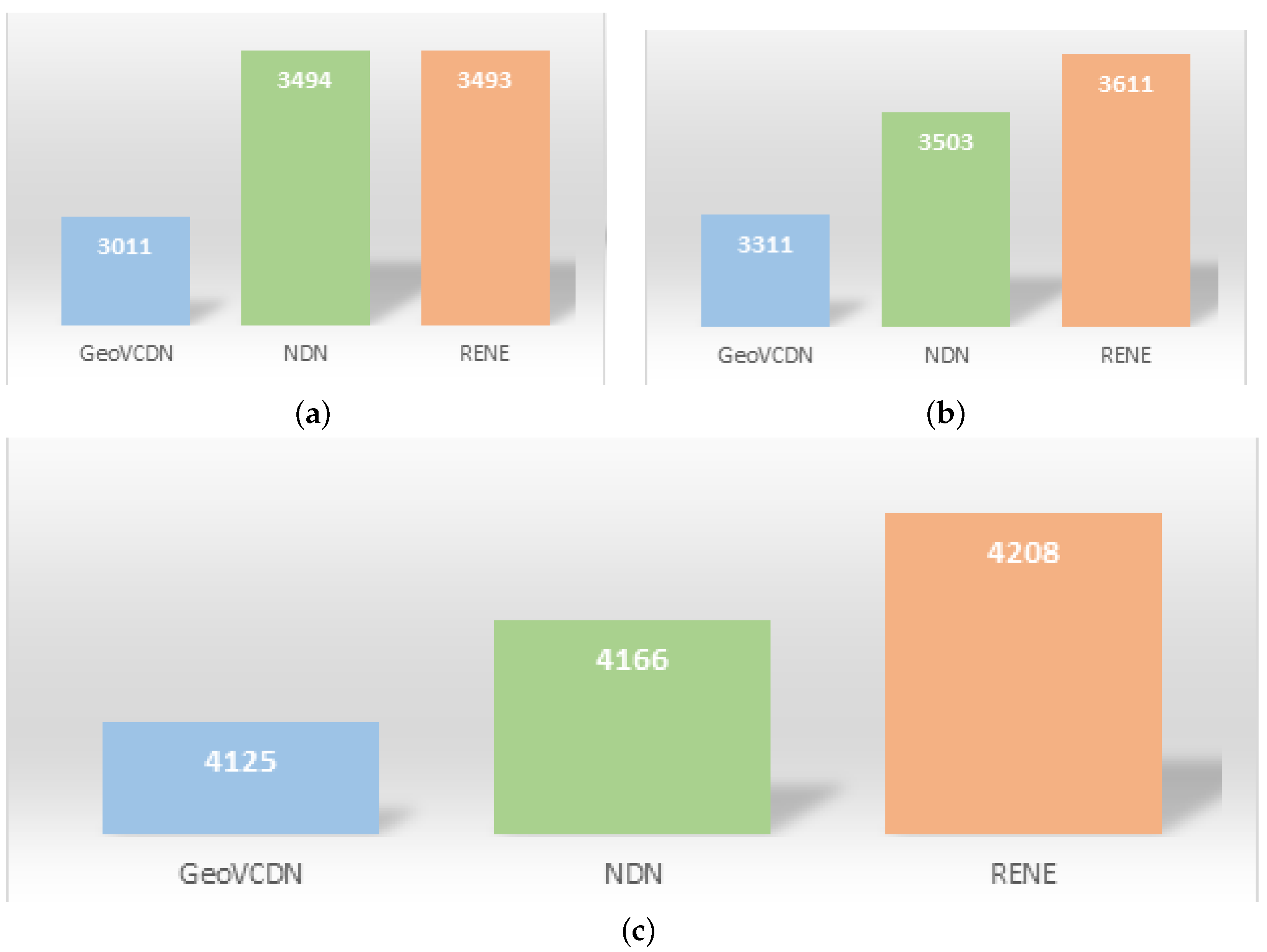5.1.1. Simulator Description
In order to validate the proposed models, we developed a simulator from scratch and
Figure 17 is an example of a screenshot.
This time-discrete simulator (with a step of 100 ms) takes into account the communication range of the vehicles and the RSUs. The mobility of the vehicles is also handled. Each vehicle emulates the full ETSI stack (geonetworking, security layer, and cooperative awareness message (CAM)) and simulates NDN, RENE, and our proposed approaches. According to the already discussed working hypothesis, it uses a Manhattan city topology and the vehicles are homogeneously spread. At the start, RSUs are randomly placed on the junctions and the vehicles are stationary. After the setting up, the core of the simulator is awakened, making the vehicles move at a constant speed and proceeding to the ICN exchanges between the ITS stations. After a threshold, the RSUs start transmitting at a regular frequency for 10 s. At the end of these 10 s, we save the results on the network overhead and the data freshness. Then, the process is repeated 20 times from the RSU placement step. Finally, we average the results.
Table 8 shows the specifications of the computer that the simulations have been run on. Due to these performances, we were limited to small-scale default values for every variable, which are given in
Table 9). However, despite these limitations, we manage to distinguish the curve’s trend. Let us note that the values are realistic and based on our observations in European C-ITS pre-deployment projects Scoop, InterCor, and C-Roads.
5.1.2. Network Overhead Simulation Results
We define the network overhead as being the data size that is shared between the different actors, over the G5 channel, on the whole network, and which is associated with the ICN exchanges. For the following figures, we will not show the NDN approach, because its results are on average hundred times higher than the other approaches, which makes it impossible to observe the differences between the other ones (as is shown in
Figure 18). Vehicles play a core role in the G5 network overhead. They represent the biggest part in terms of stations, so it is important that the proposed ICN approach scales with a high number of clients. In this section, we will see how the number of vehicles and their communication range impact the network overhead for each approach.
First, in
Figure 18, we compare NDN and VCDN when we increase the number of vehicles. For NDN, the amount of data and exchanged interests proportionally increases with the number of vehicles in the network. Using VCDN, the number of interests also increases in the same way, but slower because there is only one interest per vehicle. On one hand, for NDN, the data are sent once per vehicle, and every time a vehicle asks, for VCDN the data are only sent when updated. On the other hand, VCDN generates a gain on the security layer. Indeed, for NDN, we have as many security headers as sensors, whereas for VCDN there is only one security header whatever the number of data is. We see that the mechanisms of metadata and sequence number make a significant difference by reducing the network overhead related to ICN exchanges and making ICN more scalable. For 20,000 vehicles, NDN generates 1.2 GB/s of data, whereas for VCDN it only generates 12 MB/s.
We will compare the behavior of each approach by changing the parameters associated with the vehicles (number and transmission range), the RSUs (number and transmission range), the network (size and coverage area), and the data (frequency, size, and the number of sensors).
In
Figure 19, we compare all the approaches excluding NDN. We already show that NDN is worse than VCDN and it appears that VCDN is the worst approach of the remaining ones, which that is why in the following figures we will not show NDN. Yet, the results will appear in the comparison tables. Using RENE, the vehicles send more interest than VCDN (one per sensor), but only the updated sensors send their data. For VCDN, the data of every sensor are sent when at least one sensor is updated. Because the data packet’s size is higher than the interest’s one, the performances of RENE are better than VCDN when the number of vehicles increases. The best performance is obtained for VCDNoCAM since the number of vehicles has no effect on the network overhead caused by the data sending. Using GeoVCDN, we add the exchanges between vehicles out of the coverage area and that is why GeoVCDN’s overhead is higher than VCDNoCAM’s. Still, despite this mechanism that increases the network overhead, GeoVCDN is more scalable than RENE.
In order to validate the proposed model, we present, in
Table 10, a comparison between the expected values from the analytical model and the observed values from the simulations for 411 vehicles.
We note a difference around of 1%, which confirms our model’s behavior based on the number of vehicles.
Furthermore, considering that the range of the vehicle is lower than the RSU’s (which is a realistic consideration), this only has an impact on the GeoVCDN approach, because it is the only one which handles the V2V communications, as we can see in
Figure 20. We have a smoother increase between 50 and 100, which refers to the phase when the inter-distance is almost sufficient enough to have all vehicles connected together. In this simulation, we had a 107-meter inter-distance. After this threshold, we observe a slow decrease, as the number of hops to cover a segment decreases.
For a vehicle range of 150 m, in
Table 11, the difference between the model and the simulation is very low (about 0.5%), except for the NDN.
In an intelligent transport system network, RSUs are the gateway between the vehicles and the rest of the world. Increasing the number or the range of RSUs will increase the number of data access points. Thus, in most cases, the network overhead will increase. We will show how the network overhead is affected by the number or the quality of RSUs for each approach.
Increasing the number of RSUs makes the coverage area bigger, which increases the number of vehicles concerned by the ICN messages. Furthermore, it also increases the number of entering points to the coverage area. The increase in the number of RSUs has a good impact on the GeoVCDN approach, as we can see in
Figure 21. The more RSUs there are, the less there are exchanges between vehicles, since the RSUs already cover a part of the city. Additionally, we see that for RENE and VCDN, raising the number of RSUs leads to a significant increase in the overhead. For RENE, the overhead generated with interests is related to the number of entering points to the coverage area, whereas for VCDN it is about the coverage area itself. Concerning the data, with RENE and VCDN there are more vehicles to which the data must be delivered.
Table 12 lists a comparison between the expected values and the observed ones for five RSUs.
For RENE, VCDN, and VCDNoCAM, the difference between the analytic model and the simulation’s results is around 2% (
Table 12). For the NDN approach, the simulation gives a result 7% higher, whereas for GeoVCDN, the result of the simulation is lower than the one given by the analytic model (7%).
Furthermore, the RSUs’ range modifies the coverage area and so the number of vehicles receiving the data (
Figure 22). For the VCDN case, the consequence is the same as if we increase the number of vehicles: more interest and more data. For RENE, the coverage area does not affect the overhead related to the interests, which represents the biggest part of the overhead for this approach. However, we send the data to more vehicles, which is why we can observe a slight increase. Using VCDNoCAM, the effect of the coverage area is null on the overhead related to the data. It only affects the overhead related to the interests. GeoVCDN is the unique approach, tending to decrease the throughput when increasing the RSUs’ range because fewer V2V exchanges are needed to spread the data.
Table 13 presents a comparison between the expected values and the observed values with the RSU’s range of 150 m.
Again, the table confirms the analytic model when the RSU’s range changes. Indeed, we can see that the difference between the model and the simulation is very low (0–2%).
For VCDN, RENE, and VCDNoCAM, the increase of the data generation frequency leads to a similar behavior for the overhead related to it, as we can see in
Figure 23: with the increase of the data generation frequency, we increase the data amount transiting in the network. Using VCDNoCAM, we are limited by the CAM frequency (10 Hz), which is why the network overhead is constantly passed. We can see that with GeoVCDN, the higher frequency is, the fewer exchanges between vehicles. Passed 10 Hz, the exchanges between vehicles decrease (because the maximum hop limit is computed based on the data generation frequency). For this reason, from this point, the higher the frequency, the lower the consumed bandwidth within the GeoVCDN approach.
Table 14 confirms that the difference between the expected and measured values for a frequency X is very low (between 1 and 2%).
5.1.3. Data Freshness Simulation Results
The data freshness is measured as the percentage of vehicles which receives the data before the latter expires. The data expire when updated data have been generated. In our environment, the data frequency () fixes the validity duration. We will compare the behavior of each approach by varying some parameters associated with the vehicles (number and range), the RSUs (number and range), and the data (frequency).
Because the analytic model is pessimistic about the data freshness associated with GeoVCDN, the simulation will always give better results. The gap between the two results will be higher if there are more or fewer RSUs because the analytic model does not take into account the dissemination to the segments without RSUs.
On one hand, the communication range of the vehicles has no effect on the approach that does not handle the V2V exchanges, as we can see in
Figure 24. However, for the GeoVCDN approach, where the vehicle’s transmission range is high enough to communicate with the surrounding vehicles, the freshness increases until it quickly reaches 100%, if the hop limit allows it. For example, with a range of 150 m, with GeoVCDN, we reach a freshness of 100% compared to 60% with the other approaches. With a range lower than the inter-distance, we still do better than the other approaches with almost 16% more vehicles receiving the data, thanks to the bidirectional traffic. The more we increase the range, the more we optimize the broadcast from client to client; finally reaching the optimum freshness if the other parameters allow it.
Table 15 presents a comparison between the expected values and the observed values for a vehicle range of 150 m.
The differences between the obtained values with the model and with the simulations are small (max three points).
As shown in
Figure 25, where
, increasing the number of vehicles does not have any effect on the approaches that do not handle the V2V exchanges. As expected, the percentage of vehicles in the coverage area and entering the coverage area before the expiration of the data remains the same, since the vehicle distribution is homogeneous and their speed is constant, so the freshness is also constant. Because the freshness is expressed as a percentage, the absolute amount of vehicles has importance only for the GeoVCDN approach. With this one, the increase in the number of vehicles has a positive effect on the freshness because we optimize our transmission range and our farthest neighbor is located farther away, so we cover a bigger area. Let us note that the freshness is limited by other settings such as the hop limit. With 170 vehicles, the GeoVCDN approach sees its freshness 50 points above the others. With 1000 vehicles, the performance is even better with 99% of the vehicles which obtain the information before it expires against 40% with the other approaches. The performance increase is logarithmically evolving according to the inter-vehicle distance.
The comparison between the expected values and the observed values for 267 vehicles are listed in
Table 16.
These results confirm the validity of the analytic model when we make the number of vehicles change. In this scenario, about a quarter of the segments are not covered by any RSU, which is why the analytic model gave such results.
Increasing the range of the RSUs means increasing the number of vehicles within their ranges. In
Figure 26, we observe that the consequence is the same for all the approaches with better performance for GeoVCDN. The more we increase the range of the RSUs, the more we reduce the hops that the messages have to do using the V2V exchanges. We note that for the GeoVCDN approach, in the end, the freshness reaches 100%.
A comparison between the expected values and the observed ones for an RSU transmission range of 100 m is presented in
Table 17.
For the approaches NDN, RENE, VCDN, and VCDNoCAM, the difference in the results is almost null.
In
Figure 27, we see that increasing the number of RSUs has a positive effect on the freshness of all the approaches. It increases the number of entering points of the coverage area, which increases the number of vehicles being in it when the data are generated. For GeoVCDN, increasing the number of RSUs means increasing the number of starting points for the propagation of the data in V2V, which explains that the curve increases quicker than the other approach For GeoVCDN, the more RSUs there are, the more vehicles are able to forward the data. This is why we have a logarithmic curve in
Figure 27. A comparison between the expected values and the observed ones is given in
Table 18.
Again, since almost half of the segments do not have any RSU, the analytic model gave a worse result than the simulation for GeoVCDN.
By increasing the data generation frequency, we decrease the hop limit and so the number of vehicles, which can be affected by the V2V communications (GeoVCDN). For VCDN, NDN, and VCDNoCAM, we observe, in
Figure 27, a slight loss, caused by the decrease in the number of vehicles entering the coverage between two generations. For RENE, whatever the frequency is, the number of vehicles inside the coverage is constant, so the freshness also remains constant.
Finally, the more often data are sent, the less time the vehicles have to forward them. That is why, as we can see in
Figure 28, the freshness decreases only with the GeoVCDN approach. For RENE, the frequency does not have any effect. For the others, the effect is almost null, there are fewer vehicles entering the coverage area before the expiration of the data and that is why we observe a slight loss. Despite this decrease in GeoVCDN, it outperforms all other approaches even with high data frequency updates thanks to the benefits of V2V communications.
5.1.4. Discussion
This analytic evaluation highlights the efficiency of our approaches. VCDNoCAM provides the same service as already existing ones (NDN and RENE) for freshness, but with a lower cost on the network overhead. The NDN method gives disastrous results in an environment where the data are numerous and often change; resulting in the need to send interests very often for all data to ensure to keep them updated. NDN has been thought to make the network traffic lighter without taking into account the link to the client. Yet in vehicles, the G5 channel has a reduced bandwidth, and we have to save it as much as possible. So, if want to guarantee the authenticity and integrity of every message, it quickly becomes cost ineffective. We saw that we managed to save this network overhead related to the security layer by grouping a set of data in one set of metadata, which is heavier, but makes it possible to reduce the number of security data to only one occurrence. We also added a sequence number mechanism, which avoids sending the data to someone who already has them. Despite these two mechanisms, still, the results are not satisfying (VCDN). The RENE method is more adapted to such an environment because the data are only pushed when it changes. However, as with NDN, the final link towards the client is not taken into account and every vehicle in the same RSU’s area is going to individually receive the information. By exploiting the existing technologies, we manage to widely reduce the cost of the data related to the ICN exchanges (VCDNoCAM), by integrating these exchanges in the standardized regularly broadcasted messages (CAMs). Thus, we use the CAM’s security layer. In addition, the data are sent to every vehicle in range with only one message. The results highlight the gain in network overhead with this method. Finally, we also use CAMs to send the data farther than only RSU’s range (GeoVCDN). This additional functionality improves the quality of service but has a cost on the network overhead. However, it stays lower than the existing ICN methods, and, as we saw, it is more scalable.
